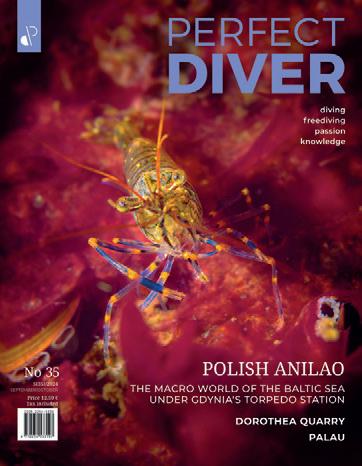6(36)/2024
NOVEMBER/DECEMBER
Price 12,50 € Tax included

diving freediving passion knowledge

6(36)/2024
NOVEMBER/DECEMBER
Price 12,50 € Tax included

diving freediving passion knowledge




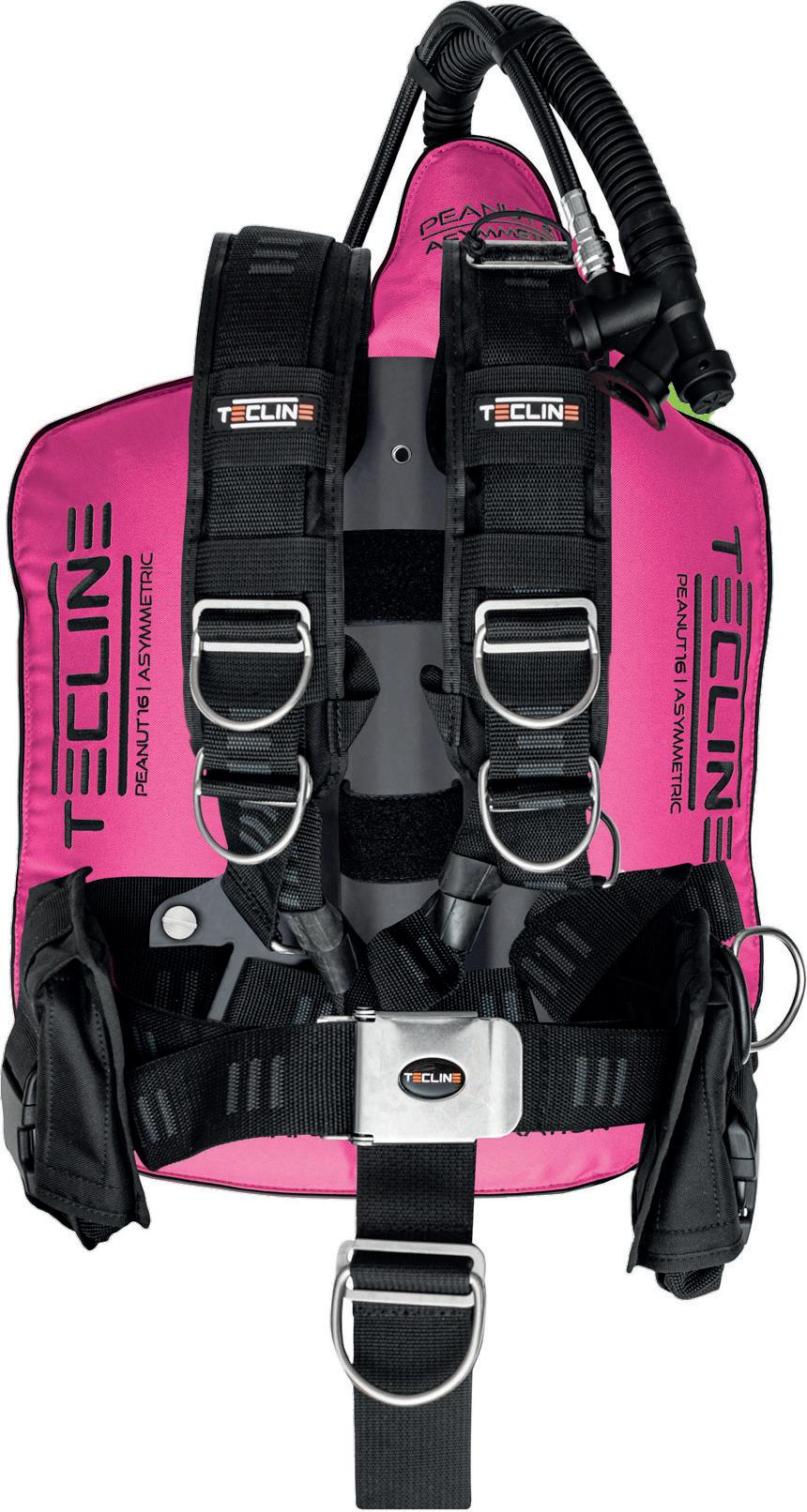


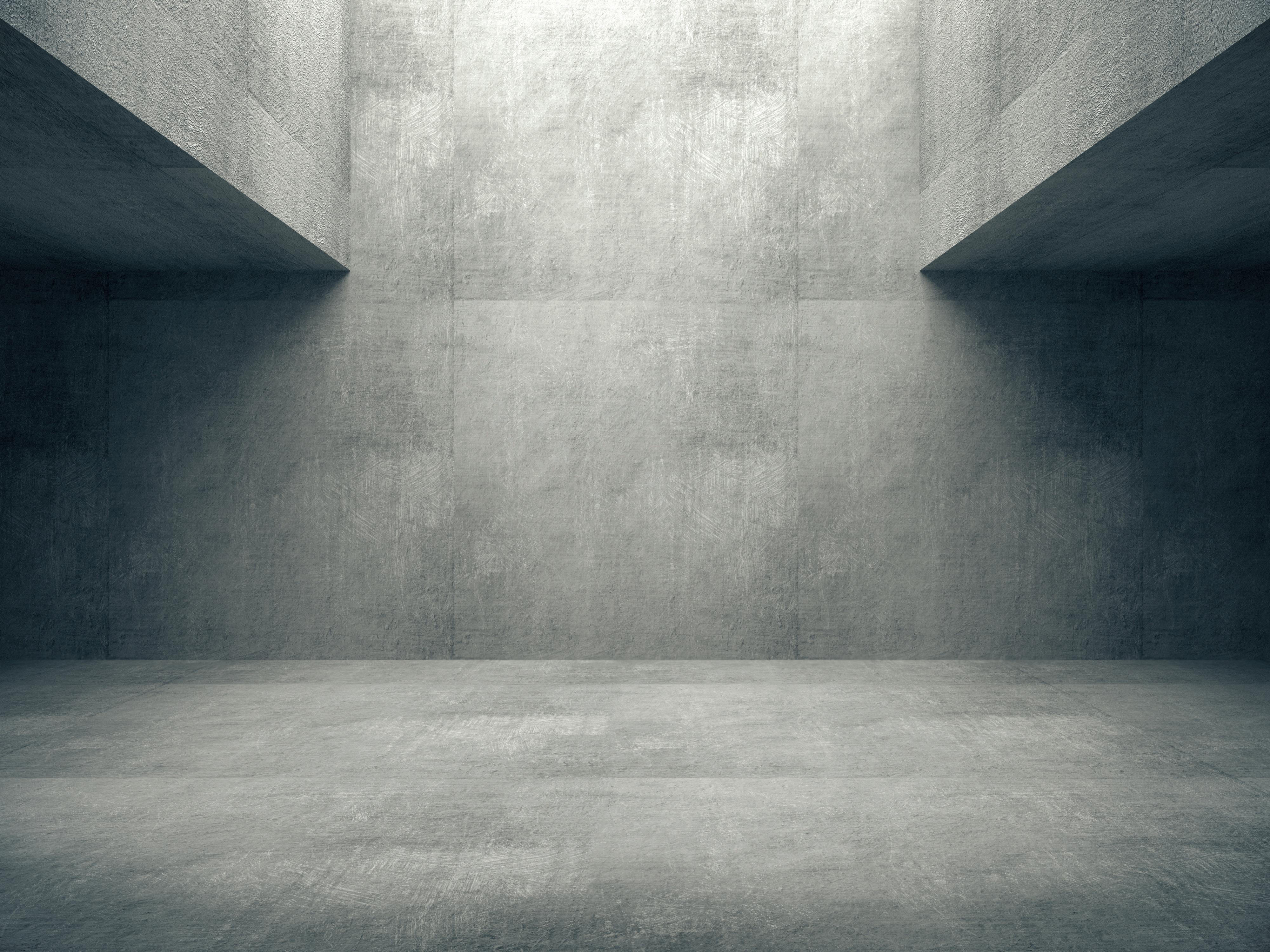


Dear Readers,
Wojciech Zgoła Editor-in-Chief
We present to you another, unique edition of Perfect Diver – full of inspiration, underwater adventures and practical advice. This time we invite you to discover the diving world from many extraordinary perspectives.
We set off to Lombok to immerse ourselves in the shadow of the volcano, admire the blacktip sharks of Raja Ampat and explore the magical gardens of Xibalba. For lovers of diving in fresh waters, we have Macedonia and the Dorothea quarry, as well as reports from the clean-up of our native water reservoirs – because every clean lake is a win-win situation.
Are you curious about how to become an underwater model or how best to pose for photos in the water? In this issue you will find some important tips. In turn, in the tips and trivia section, we suggest which gloves to choose for cooler dives and how to dive safely and comfortably with people with disabilities.
Winter is a time when many of us look forward to exceptional ice dives – we keep our fingers crossed for the ice! And finally... We are pleased to present the Grand Prix of the Nautica Safari underwater photo competition, which adorns our cover. More on this in the next issue.
And don't miss the opportunity to sign up for 2025! In the new season, we focus on convenience – we ship via inPost. Give us your e-mail, phone number and your favourite mailbox, and your magazine will go straight to your hands.
However, before you fully immerse yourself in the issue, we want to give you our warmest wishes:
Happy and joyful Christmas and make all your dreams come true in 2025!
Dive into this edition with us!
Perfect Diver Editorial Team
Did you like this issue? Give us a viral coffee buycoffee.to/perfectdiver Visit our website www.perfectdiver.com, check out Facebook www.facebook.com/PerfectDiverMagazine and Instagram www.instagram.com/perfectdiver/










Publisher PERFECT DIVER Sp. z o.o. ul. Folwarczna 37, 62-081 Przeźmierowo redakcja@perfectdiver.com ISSN 2545-3319
Wojciech Zgoła
Karolina Sztaba
Anna Metrycka reklama@perfectdiver.com
Agnieszka Gumiela-Pająkowska Arleta Kaźmierczak
Reddo Translations Sp. z o.o. Piotr Witek
Lawyer Joanna Wajsnis Brygida Jackowiak-Rydzak
Montserrat (Julieta Ulanovsky), Open Sans (Ascender Fonts) Noto Serif, Noto Sans (Google)
Wieland Drukarnia Cyfrowa, Poznań, www.wieland.com.pl
distribution dive centers, online store preorder@perfectdiver.com the magazine was



WOJCIECH
Passionate about diving and pure nature. He likes to say that he travels by diving. He learned to swim when he was less than 6 years old. At the age of 15, he obtained a yacht sailor's license and has been diving since 2006. He has completed over 800 dives in various regions of the world. He wrote and published many articles.
Co-author of photo exhibitions. An advocate of leaving the place of residence clean and unblemished. Diving promoter. Since 2008 he has been running his own website www.dive-adventure.eu
Based on extensive experience, in 2018 he created the new Perfect Diver Magazine, which has been successfully published regularly every two months in Polish and English for 6 years.

A graduate of geography at the University of Wrocław, an incorrigible optimist... permanently with a smile on her lips I have been diving since 2002, which is more than half of my life I started diving in Polish waters, to which I willingly return during the year – and it gives me great pleasure! :) I must have come to Activtour by destiny and I have stayed here for good... for over 10 years! I am passionate about fulfilling people's dreams by preparing diving trips around the world! Personally – I fly and dive in different seas and seas whenever I can, because it is one of the loves of my life Since the beginning of the existence of the PD magazine, I have been transferring my memories of diving trips to paper, sharing my passion with others and I can't stop writing ;) 2023 permanently in the PD editorial office – hoping to bring her some "fresh blood" ;) A diving dream come true: Galapagos! Still ahead of me… Antarctica! If I don't dive, I choose skiing, tennis or strong rock sounds! ;) The motto that I really like is: "Be realistic – start dreaming"! :) anna@activtour.pl; www.activtour.pl;

A traveller and a photographer of wild nature. A graduate of journalism and a lover of good literature. She lives in harmony with nature, promotes a healthy lifestyle: she is a yogini and a vegetarian. Also engaged in ecological projects. Sharks and their protection are especially close to her heart. She writes about the subject in numerous articles and on her blog www.blog.dive-away.pl. She began her adventure with diving fifteen years ago by total coincidence. Today she is a diving instructor, she visited over 60 countries and dived on 5 continents. She invites us for a joint journey with the travel agency www.dive-away.pl, of which she is a co-founder.

My adventure with photography began long before I started diving. From the very first dive I dreamed that I would be accompanied by a camera. As I became more adept at diving, my photography gear evolved as well. From a simple gopro camera through a compact and SLR camera to a full-frame mirrorless camera. Now I can't imagine diving without a camera. I have the impression that underwater photography gives meaning to my diving. www.facebook.com/przemyslaw.zyber www.instagram.com/przemyslaw_zyber/ www.deep-art.pl

Karolina Sztaba, and professionally Karola Takes Photos, is a photographer by education and passion. She is currently working at the Trawangan Dive Center on a tiny island in Indonesia – Gili Trawangan, where she moved to live four years ago. She photographs above and below the water. In addition, she creates photographic projects against littering the oceans and polluting our planet with plastic ("Trapped", "Trashion"). She cooperates with NGO organizations dealing with environmental protection and actively participates in pro-ecological actions (coral protection, coral planting, cleaning the world, protection of endangered species). She is also the official photographer of Ocean Mimic – a brand that creates swimwear and surfwear from rubbish collected on the beaches of Bali. She cooperated with many brands of diving equipment for which she created advertising campaigns. In 2019, she became the ambassador of the Polish company Tecline. She has been a technical diver for two years.

Laura is a journalist, instructor trainer, CCR and cave diver. She has been developing her diving career for over a decade, gaining knowledge and experience in various fields. Her specialty is professional diving training, but her passion for the underwater environment and its protection drives her to explore various places around the world. From the depths of the Lombok Strait, caves in Mexico and wrecks in Malta to the Maldives, where she runs a diving center awarded by the Ministry of Tourism as the best diving center in the Maldives. Laura actively contributes to promoting the protection of the marine environment, takes part in scientific projects, campaigns against ocean littering and cooperates with non-governmental organizations. You can find her at @laura_kazi_diving www.divemastergilis.com

He has been diving for 35 years. He has spent more than 16,000 hours underwater, most of them diving technically. He has been an instructor and mentor instructor for many organizations including CMAS, GUE, IANTD, PADI. He co-created the training programs for some of them. He is a professional with vast knowledge and practical experience. He has participated in many diving projects as a leader, explorer, initiator or speaker. He was the first Pole to dive the HMHS Britannic wreck (117m). He was the first to explore the deep part of the Glavas Cave (118m). He made a series of dives documenting the wreck of ORP GROM (110m). He has documented deep (100-120m) parts of flooded mines. He is the creator and designer of many equipment solutions to improve diving safety.
Technical Director at Tecline, where, among other things, he manages the Tecline Academy a research and training facility. Author of several hundred articles on diving and books on diagnosis and repair of diving equipment.
He dives in rivers, lakes, caves, seas and oceans all over the world.

He has been diving forever, he does not remember his first dives. The only thing he remembers is that diving has always been his passion. He spent his entire childhood on Polish lakes, which he still prefers to distant destinations. With great success, he turned his passion into a way of life and business.
Curiosity of the world and constant striving for perfection are the main features that definitely hinder him in life. Professional diving instructor, photographer, filmmaker.
Creator of the DECO Diving Center, PADI Course Director, TecTrimix Instructor Trainer TECREC.

A long, long time ago in a galaxy far, far away there was chaos...
…that is, the multitude of thoughts and delights after my first immersion under water in 2005 in the form of INTRO while on vacation in Egypt. By then I had completely immersed myself in the underwater world and wanted it to have an increasing impact on my life. 2 years later, I took an OWD course, which I received as a gift for my 18th birthday, and over time, further courses and skills improvement appeared.
"Photography" appeared not much later, but initially in the form of a disposable underwater "Kodak" from which the photos came out stunningly blue I am not a fan of one type of diving, although my greatest weakness at the moment is for large pelagic animals. The Galapagos Islands were my best opportunity to photograph so many species of marine fauna so far.
I share my passion for diving and photography with my buddy, who is my wife IG: luke.divewalker www.lukedivewalker.com

A graduate of two Poznan universities, the Academy of Physical Education (coaching specialization – handball) and the University of A.Mickiewicz, Faculty of Biology (specialty of experimental biology). He connected his professional life with this first university trying to influence the direction of development of future professionals on the one hand, and on the other planning and implementing research, pushing laboriously in the right direction of the stroller called science. In his free time he spends his time actively – his main passions are sailing (sea helmsman), skiing (downhill skiing instructor), riding a motorcycle, recreational diving and many other activities, as well as photography, mainly nature.

Zoopsychologist, researcher and expert in dolphin behavior, committed to the idea of protecting dolphins and fighting against keeping them in dolphinariums. Passionate about Red Sea and underwater encounters with large pelagic predators. Member of the Dolphinaria-Free Europe Coalition, volunteer of the Tethys Research Institute and Cetacean Research & Rescue Unit, collaborator of Marine Connection. For over 15 years, he has been participating in research on wild dolphin populations, auditing dolphinariums, and monitoring the quality of whale watching cruises. As the head of the "Free & Safe" project (formerly "NO! for a dolphinarium"), he prevents keeping dolphins in captivity, promotes ethical whale & dolphin watching, trains divers in responsible swimming with wild dolphins, and popularizes knowledge about dolphin therapy that is passed over in silence or hidden by profit-making centers. on this form of animal therapy.


„Kindness” entire adult life, as her friends call her, is professionally related to diving. She has been diving every day for over ten years as a professional PADI diving instructor, working and running diving centers in Egypt. Extremely meticulous and pedantic about safety. Specializes in training children, teenagers and women. It's impossible to miss her because she dresses her pink lifestyle in this color underwater. An accountant by education and second profession, in private she is the mother of two "terrorists". Co-owner of the DECO Diving Center.
Infected with passion for diving by Perfect Diver. He shyly expands his skills. Definitely thermophilic :) Favorite dives are those with lots of animals! Curious about diving medicine.
Professionally, she has a Master of Science in Nursing – instrumentalist.

Better known as Wąski
Professionally, the main health and safety specialist, fire protection inspector and first aid instructor. Privately, husband and father of his daughter. A member of the Bellator Societas, where he is called St. Marcin, because every year he plays the character during the name day of the street on November 11 in Poznań. Of course, for many years an avid diver. He loves technical diving, especially those on wrecks and everything related to activity above and below water :)

For Tomek, diving has always been his greatest passion. He started his adventure at the age of 14, developing into a recreational and technical diving instructor, a first aid instructor and a diving industry technician. Currently, he runs the 5* COMPASS DIVERS Pobiedziska Diving Center near Poznań, where he passes his knowledge and skills to beginners and advanced divers, which gives him great joy and satisfaction from being part of their underwater adventure...

Zodiac Libra. Enthusiast of a healthy lifestyle, fond of active leisure. Lover of the underwater world and underwater photography. HR employee, and after hours SDI diving instructor, Vital Mentor, Diet coach. Thanks to her passion for psychology, working with people and the ability to listen, she knows that everything starts in the head. He highly values the ability to communicate without words underwater. Water helped her discover completely unknown mobility possibilities, and overcoming her own limitations, as well as learning something new in the natural environment, in the context of communing with nature, helped her rebuild her mental condition.
Partner of the diving school https://wewelldiving.pl

A graduate of the Poznań University of Technology, financier, the auditor. A diver fascinated by theory diving – physics and physiology. In love passionate about history in underwater archaeology Ancient Rome, active Centurion in the group reconstructionist Bellator Societas (Rome I century BC). He dreams of attending at least once underwater archaeological research a then describe everything in a series of columns.
It can be found as often as under water in Japan, whose culture and history he has been fascinated by nearly three decades.

From an early age, Michał Bazała was fascinated by aquatic ecosystems, developing his passion for the underwater world as a biologist and aquarist. In 2014, he fulfilled his dream of personally exploring the depths. Underwater, he is almost always accompanied by a camera, and since 2022, also by students, as an instructor of the Polish IDF federation and a technical diver. He founded the Wilanówbased dive center Royal Divers, where he promotes mindful diving and emphasizes the richness and fragility of aquatic ecosystems, even in small, local ponds.
He honed his underwater photography skills while diving after work with the Group Exploring Suburban Dive Sites around Warsaw. A two-time finalist of the Underwater Photographer of the Year competition, Michał actively supports environmental protection initiatives, participating in campaigns that raise public awareness about the need to safeguard our underwater world. His greatest dream is to explore the little-known reefs of the Pacific Ocean, where he hopes to discover and document the untouched beauty of nature. www.facebook.com/bazala.fotografia www.instagram.com/michal_bazala/ royaldivers.pl, bazala.pl

In the Foundation, he is the commander-in-chief of the Clean up the World – Poland Action and manages the works of strategic projects. Grzegorz realizes himself creatively in ideas for new campaigns and methods of promotion as part of the Foundation's Clean Up the World –Poland and Eco-education programs. Arranges strategies and coordinates the work so that everything goes according to plan. During off-road activities, he wears yellow gloves and naturally carries kilograms of waste. He often takes the helm of the foundation's Facebook and Instagram profile to talk about what we can do together for our immediate surroundings. In his free time, he sails, runs and traverses mountain trails. A graduate of the Faculty of IT Management and Finance at the University of Economics in Wrocław and the Faculty of Journalism and Social Communication of the University of Lower Silesia in Wrocław. Certified specialist in the field of obtaining EU funds and communication on the Internet.





The Indonesian island of Lombok, located on the Australian continental line, is a place where many animal species have never crossed over. Its fascinating geological history has created some of the best, yet less known diving spots.
Whether you're a recreational or technical diver, a fan of megafauna, or a macro photography enthusiast, Lombok offers a wealth of exploration opportunities at affordable prices and without crowds. Additionally, you can support eco-tourism by planting corals or building structures to help restore coral reefs. Forget Bali, which is popularized by influencers. A 30-minute flight to Praya Airport will take you to a much more authentic destination.

The Gili islands (Trawangan, Air, and Meno) are my favourite destination and at the same a must-see. Not only because of the best diving in Indonesia, which you cannot miss, but due to the atmosphere. The diving camaraderie on these carefree islands will make you feel at home instantly. Attracting backpackers and young diving enthusiasts, it's a perfect place to start your diving journey or continue your education as a professional. It's one of the best and most affordable


places to train as a Divemaster or Instructor. At the diving centre Trawangan Dive, you'll have the chance to participate in beginner and advanced courses, gain experience diving in strong currents, and hone your marine life identification skills – the species diversity is staggering. And of course, let us not forget the turtles. Giant green turtles are abundant at most dive sites. On one dive, I counted as many as 27! No, it wasn’t the same turtle swimming in circles, I promise.

Technical diving is also a great option. Just 20 minutes from the island, you'll find yourself at the edge of the Wallace Line, descending into the depths of vertical walls that host incredible ecosystems. The plateau begins at around 40 meters, and the bottom is far below at over 300 meters. It's no wonder you can encounter sharks, mola mola, and a variety of rays here. First of all, it's worth going deeper here because of the topography and coral reefs. Two-meter gorgonians covering this vertical reef strive to catch as much light and passing plankton as possible, and they pose beautifully for photos. Here, you can also encounter massive Antipatharians, or black corals, set against the backdrop of the deep blue depths, where time seems to lose its meaning, and the vastness of the underwater landscape reminds us how small we are in this aquatic expanse.
For ecology enthusiasts, there are fantastic opportunities through Gili Eco Trust, a non-profit organization focused on protecting and restoring coral reefs. One of their projects is BioRock, led by Delphine. This innovative method of reef restoration, addressing damage from climate change and tourism, prevents shoreline erosion and rebuilds underwater ecosystems. BioRock uses metal structures with a low-voltage electric current passed through seawater to stimulate coral growth. During
a two-week course at Trawangan Dive Center, you’ll learn this technique, study coral biology, and design, build, and install your own BioRock structure on the reef.
The Gili Islands are the most popular destination on Lombok. If you're looking to escape crowds and don’t plan on professional training, head straight to Lombok's Belongas region. Here, breathtaking experiences await with the Wild Scuba team. Jay and his crew have been exploring the dive sites in this area for years. As a small dive center, you can expect a friendly, family-like atmosphere. Wild Scuba’s passionate divers are eager to share their knowledge about marine creatures and fish species found here, as well as techniques for diving in strong currents.
Belongas and its surroundings offer incredible dive spots. Magnet is an underwater rock barely breaching the ocean surface in open water, known for its strong and challenging currents and as an iconic dive site. It's one of the few places in the world where, from May to December, when water temperatures drop to 20-25°C, you can spot schools of hammerhead sharks. But that’s not all. Descending here, you’ll encounter massive schools of barracudas, tuna, giant trevallies, almaco jacks, bigeye trevallies, as well as occasional whale sharks, mantas, and mola mola.

Nearby, Gili Sarang offers schools of mobula rays, stunning topography, and coral life. East of Magnet lies Cathedral, a dive site boasting a large cave at 40 meters. This site is also subject to strong currents and often features curious sea snakes and large schools of fish seeking refuge on the reef. Cathedral offers a breathtaking and unique underwater landscape.
From Belongas Bay, it’s about an hour to reach Manta Point, where giant mantas will perform a mesmerizing dance, gracefully maneuvering their fins. You’ll often see both reef and oceanic mantas here, which frequent the area mainly for cleaning – a sort of underwater spa. Besides mantas, you’ll often encounter octopuses, reef sharks, lionfish, and scorpionfish.
When water temperatures drop to around 16-20°C (time for a dry suit, in my case), there’s a good chance of meeting a "marine dinosaur" – the mola mola. These peculiar fish can be found at several dive sites, especially those exposed to strong currents.
The underwater coral reefs and topography here will satisfy even the pickiest divers who’ve been everywhere and seen everything, leaving even the fjords in awe. Expect small caves, swim-throughs, coral fans, rocks, and walls. However, there’s one catch – to dive with Wild Scuba around Belongas,
you’ll need at least an advanced diving certification and a record of at least 100 dives. This is due to potentially challenging conditions, where currents can be very strong, water entries are often negative, and the waves can create an underwater "roller coaster." On the upside, experienced divers can expect unforgettable, adrenaline-filled dives in small groups and breathtaking encounters with nature.
For less experienced divers, the Wild Scuba team offers Secret Gilis. These dive sites are more sheltered from currents and are popular among photographers due to their diverse macro life. Southern Gilis provide a true escape from civilization and crowds, with a few boutique resorts offering comfort away from the hustle and bustle, alongside stunning views of green islands surrounded by azure waters.
Another unmissable destination is Kuta Lombok, where Blue Marlin Dive, located in the heart of this tourist town, offers courses and dive trips for both beginners and advanced divers. Dive sites are located in the Alas Strait, between Lombok and Sumbawa, as well as in the protected Tanjung Ringgit area –offering over 15 dive locations. Since the Blue Marlin Dive team has been exploring new dive sites for years, you can expect to be the only dive boat in the area.




INFORMATION:
Questions for Kazi, the author: email: info@divemastergilis.com DM on insta: @laura_kazi_diving
DIVING:
Belongas
WILD SCUBA INDONESIA
WA +62(0)877 5021 5327
email: wildscubaindonesia@gmail.com www.wildscubaindonesia.com Insta @wilsscubaindonesia
Gili Trawangan
TRAWANGAN DIVE CENTRE
WA +62(0)811 3810 2929
email: info@trawangandive.com www.trawangandive.com Insta @trawangandive
Kuta Lombok
BLUE MARLIN DIVE
WA +62(0) 823-4098-6987
Email: info@bluemarlinkutalombok.com www.bluemarlindive.com/lombok_kuta Insta @bluemarlindivekutalombok





”Travel makes one modest. You see what a tiny place you occupy in the world.”
Gustave Flaubert
Every journey is a new story that we create through our experiences and the way we view the world. The people we travel with, and their sensitivity, allow us to rediscover even familiar places. Our story about Raja Ampat began seven years ago in Sorong when we landed early in the morning at Jefman Airport in West Papua, Indonesia.
Seven years have passed since we first visited Raja Ampat –the last paradise on Earth. During each trip, we stayed on Yeben Island, which I detailed in Perfect Diver magazine, issue 4. During our first three stays, every dawn, we observed about fifty small blacktip sharks, their dorsal fins cutting through the emerald water, tinged crimson by the first rays of the rising sun. The sight was spectacular. The sharks swam in a tight group, alert and focused on their potential prey – schools of small fish. The abundance of fish and sharks was astonishing; I had never encountered such richness of marine life without diving below the water's surface.
Raja Ampat is known as the "Heart of the Coral Triangle," encompassing the waters of Malaysia, Indonesia, the Philippines, and Papua New Guinea. It boasts the world's greatest marine biodiversity. It remains one of the most pristine places on Earth, both above and below the water's surface. Home to over 540 coral species, with new ones continually discovered, the region also hosts more than 1,070 reef fish species and 699 types of molluscs – and these numbers keep growing. Raja Ampat is a true haven for researchers, oceanographers, underwater conservationists, and volunteers dedicated to planting and protecting coral reefs.
The area is also famous for its rainforests, home to countless bird species. Over seven years, we noticed a gradual decline in

shark populations, primarily due to poaching and development in the region. We hoped that a liveaboard safari would allow us to witness once again the shark schools we remembered from years ago. Thus, in September, we embarked on a nineday journey through Raja Ampat's waters to reach more remote locations than we had visited before.
From Sorong Airport, we headed straight to the harbour. Along the way, we passed modest, colourful, metal-roofed houses where local residents live. Iron gates and barred windows protect their homes. The roadside was lined with exotic plants, cats basking in the sun, and uniformed children heading to school. The sweltering heat made everything seem to move in slow motion, except for our taxi, which sped along, dodging small puddles left by the monsoon rains. After fifteen minutes, we arrive at the port, where we transfer to dinghies, small black inflatable boats that take us to the safari boat anchored about ten minutes from the shore. The ship is stunning; the closer we get, the more it captivates us. Made of wood, it appears to blend seamlessly with the water, thanks to its natural colours. We board via wooden stairs, holding onto a rope railing. The crew greets us with chilled towels and refreshing drinks. It's early morning, and the air temperature already exceeds 28°C. Slowly, we get acquainted with the crew and the beautiful ship, where we’ll spend nine nights. In the late afternoon, we set sail through the waters of Raja Ampat.
We glide towards the setting sun; the water’s surface is calm, smooth as velvet. The captain halts the boat at the perfect moment when the sun begins its slow descent into the ocean. The orange glow tints the crystal-clear water. We dive in to cool off – swimming at sunset is an indescribable pleasure.


Each day is more spectacular than the last, even when it seems impossible. Every morning, I wake before dawn to watch the sunrise from the upper deck. Streaks of colourful light touch the water’s surface, briefly uniting sky and earth. After sunrise, we gather in the dining area for a briefing, where the boat manager discusses the day’s diving plan in detail. We dive three or four times a day, with each dive lasting 60–70 minutes.

While diving in Raja Ampat, we experience mesmerizing, otherworldly beauty that’s hard to put into words. We swim among countless fish of various sizes, colours, and shapes. Some are tiny and translucent; others shimmer with all the colours of the rainbow. Some swim in pairs, while others form massive schools, like barracudas. The fish are curious about us, observing and surrounding us, moving as one organism that changes direction and shape in unison. There’s no need to search for reefs

or marine creatures here; everything is within arm’s reach. All we have to do is stop and look around to fully absorb this place.
We often dive over a seabed covered in both soft and hard corals. We encounter anemones where clownfish of all colours and shades hide. Some are black and white, others salmon with a white stripe along their bodies, and others still are orange or burgundy. During each dive, we spot turtles that, depending on the time of day, are either sleeping nestled in the reef or feeding on coral. We watch enormous mantas enjoying grooming sessions offered by small cleaner fish. Occasionally, we see carpet sharks, rarely found elsewhere in the world, resting on the sandy seabed, usually hidden in the reef.
All the dive sites in Raja Ampat are breathtaking, but three stand out in my memory. The first is Melissa’s Garden, where we’ve dived multiple times at different times of the year and day. Every dive at this site ended the same – we didn’t want to leave the water. The topography of this exceptional place is extremely accessible, allowing even novice divers to enjoy its beauty. Slowly, we submerge into the warm, crystal-clear water with visibility exceeding 30 meters. We descend leisurely, stopping above a coral reef at a depth of 8 meters. Below us stretches a carpet of acropora, seemingly battling each other for space. The concept of a “coral garden” takes on a whole new meaning here. We are in the animal kingdom, surrounded by unparalleled underwater wonders where biodiversity is so rich, it’s hard to decide
where to look. We marvel at the beautiful coral formations, home to millions of colourful fish. Two enormous Napoleon wrasses slowly swim past us, entirely uninterested in our presence. A spectacular school of barracudas glimmers in the sunlit waters, swirling in golden and grey hues around their axis. Our guide spots a tiny pygmy seahorse, pink and white, wrapped around a matching gorgonian. A moray eel shyly emerges from a crevice in the rock, opening its mouth where tiny, translucent shrimp perform a dance. Two black-and-white sweetlips dart nervously, seeking refuge in the coral thicket. Nudibranchs of various colours and shapes stretch and move timidly before the camera lens. There are so many subjects to photograph, it’s hard to decide which creature to capture first.
The second place that left a special impression on us is near Mansuar Island, at the village of Sauwandarek. Home to about 200 residents, the village is particularly dedicated to preserving the region’s flora and fauna. The island is lush and green, with wooden, traditional homes covered in palm leaves situated right by the beach. A long wooden pier connects the island to the sea, providing shelter for hundreds of fish.
We arrive early in the morning, as the islanders slowly wake from their sleep. Birds frolic in the treetops, and smoke from the hearths where women prepare meals wraps around the island like a cashmere shawl. The water is crystal clear, revealing the coral reef and a turtle surfacing briefly to breathe. Sauwan-

darek is called "The Turtle City" by its residents, due to the impressive number of turtles inhabiting the coastal reef. As soon as we dive in, we spot two large turtles resting on the reef and metal frames planted with corals, created by locals as part of an ecological program aimed at protecting and restoring the coral reefs in the area. These kinds of actions, driven by deeds, education, and community involvement, demonstrate how to act to save this last paradise on Earth.
We slowly swim over the reef, and after a few minutes, we reach the Sauwandarek pier. In an instant, we are surrounded by schools of snappers, trevallies, jacks, and barracudas. All the fish seem curious about us; it’s an incredible feeling and privilege to be in their company. The dive here is shallow; there’s no need to go deeper than 10 meters to be captivated by this place's beauty. Thanks to the efforts of the locals and the protection of the area, we can admire the coral reef and its inhabitants in a state that Jacques-Yves Cousteau might have experienced long ago.
The third location is rather unusual because we embarked on an exploratory dive in a spot where no one had dived before. We were enchanted by a lush green island that rose out of the sea like an oasis, offering refuge to exotic birds. We decided to dive near this island. Moving slowly at a depth of ten meters, the visibility was spectacular. What caught our attention were schools of tiny glassfish filling the crevices formed by soft and hard corals. We also saw turtles sleeping in the reef, a carpet

shark, clownfish, an octopus, and numerous nudibranchs. After returning from the exploratory dive, we named the site “Shangri-La – the Land of Happiness.”
Every visit to Raja Ampat includes a trip to Pulau Piaynemo Island, famous for its incredible panoramic view from the mountain summit.
Wooden stairs lead to the top, and the path winds through a lush rainforest. From the summit, there’s a panoramic view of karst green islets rising from an emerald sea. The locals call this place the "Lagoon of Stars" because the limestone formations, covered in exotic vegetation, appear from a bird's-eye view to form a star pattern on the calm waters. The view from the top rewards the effort of the climb, and a swim in the "Lagoon of Stars" after descending the mountain is an unforgettable experience.
During a nine-day cruise on the emerald waters of Raja Ampat, we covered a total of 597 kilometres and spent 24 hours underwater, completing three to four dives daily. We saw only a few blacktip sharks, which appeared like fleeting ghosts before quickly vanishing. Despite the vigilance of local communities, government initiatives, and the involvement of NGOs in protecting the local flora and fauna, we encountered two large sharks lying on the reef, missing their fins. These sharks, caught by poachers, had been finned and then thrown overboard while still alive, condemning them to a slow and brutal death. Most shark species need to keep moving to ensure







oxygenated water flows over their gills. A finned shark dies in agony from suffocation. Poachers are ruthless and difficult to combat, which is why education and the involvement of local communities are essential in fighting this practice.
Shark fin soup is highly popular in many Asian cultures and is considered a delicacy believed to stimulate the appetite and have regenerative properties. It is estimated that around 80 million sharks are killed each year for their fins. These majestic creatures play a key role in the marine food chain, regulating the populations of many species. Without sharks, the balance of the marine ecosystem would be irreparably disrupted. The fight to protect sharks is a fight for all of us.


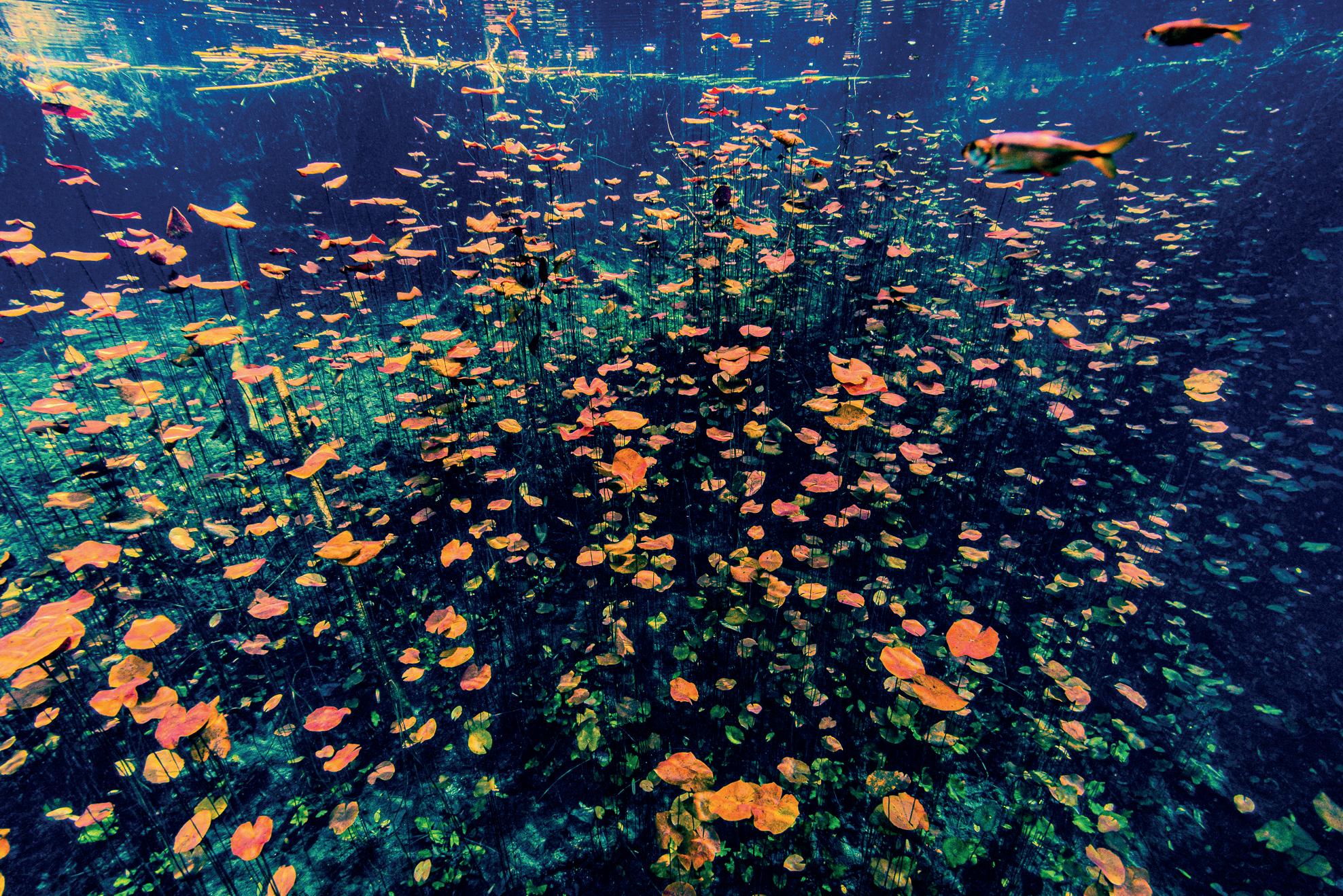
Tulum area, 500 years before Christ. Ximp had been running for too long for a twelve-year-old. His legs were crisscrossed with red scratches from countless brushes against the thorny edges of the animal trail. The boy knew that as long as he could hear the sounds of the hunt behind him, no scratch could be worse than a confrontation with the Horde.
He was beginning to doubt his chances of surviving this ordeal. He cursed the whole world for pushing him into making this decision earlier that morning. A moment of inattention cost him another cut on his cheek, delivered by a mercilessly sharp branch. His lungs burned, blood pounded in his ears, and dark spots danced before his eyes. He couldn’t go on. Their legs were longer, their thirst for blood and revenge as strong as his desire to save Rexina.

Meanwhile, the jungle was growing denser, pulling him into itself like a sticky spiderweb, forcing him to slow down. How was there so much greenery in this place when the blazing sun and the Horde had scorched the vegetation elsewhere? He didn’t have time to answer because suddenly, his feet lost their grip, and the rush of air ruffled his hair. A loud splash and a shock followed as brackish water stung his fresh wounds. Terrified, he opened his eyes. The navy-blue abyss was like

American crocodile. It turned out to be more prudent than I was and quickly drifted away into the dense undergrowth.
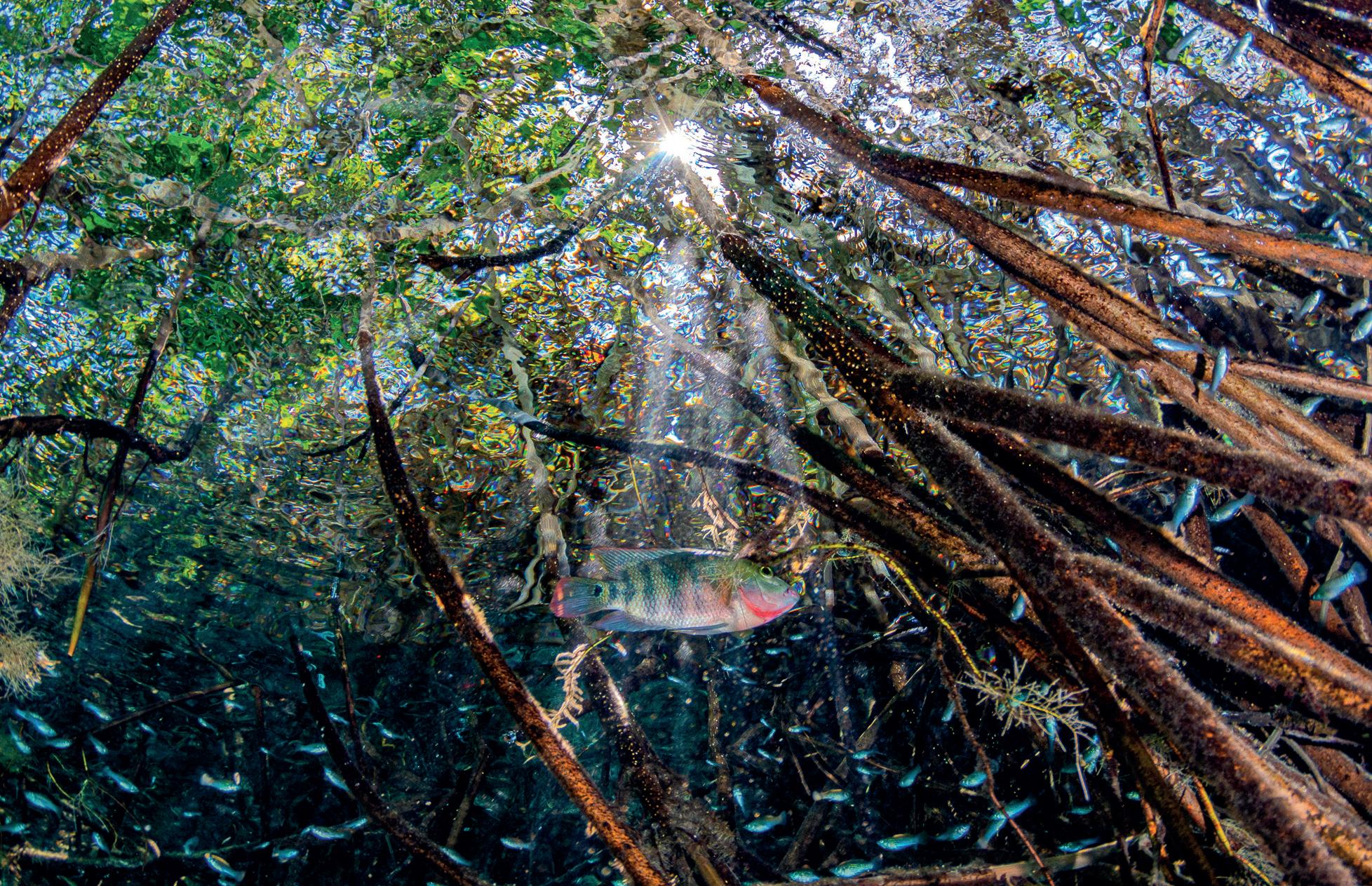
The murky water of the Angelita cenote created a fairy-tale backdrop for Gosia scanning the limestone shores.


the gates of the underworld – he had gone from one danger to another. It tormented him but also offered a glimmer of hope. He looked around. The steep walls would prevent anyone from climbing down here. He was saved! And simultaneously trapped forever.
The shores of the pool in the middle of the jungle were made of limestone overhangs. Lush greenery, heavy with dew and unheard of in the jungle above, offered perfect shelter. The moisture and sparse sunlight had created a paradise for mosses and ferns. Ximp hid beneath the roots of a fig tree that had carved its way through the rock. The pursuers passed by, not even reaching the edge of the cenote. Perhaps they would return later when they realized they were chasing a shadow? He exhaled deeply and relaxed his burning muscles. Around him, schools of cichlids and Mexican guppies, drawn by the splash, nibbled cheerfully at his dirty skin. He was surrounded by yellow flowers of banana water lilies and vibrant greenery, touched by the gentle rays of sunlight filtering down from above. Was this paradise? Had Rexina also escaped her bonds, and would they meet here in this paradise?
At that moment of reflection, another problem appeared before his eyes. It had scales, a long tail, and sharp white teeth. The vertical pupil of a crocodile had been observing Ximp intently ever since the splash disturbed its peace. For the crocodile, the sound of a splash was a welcome one – it usually meant one thing: a meal, a new flavour. The Mexican croco-
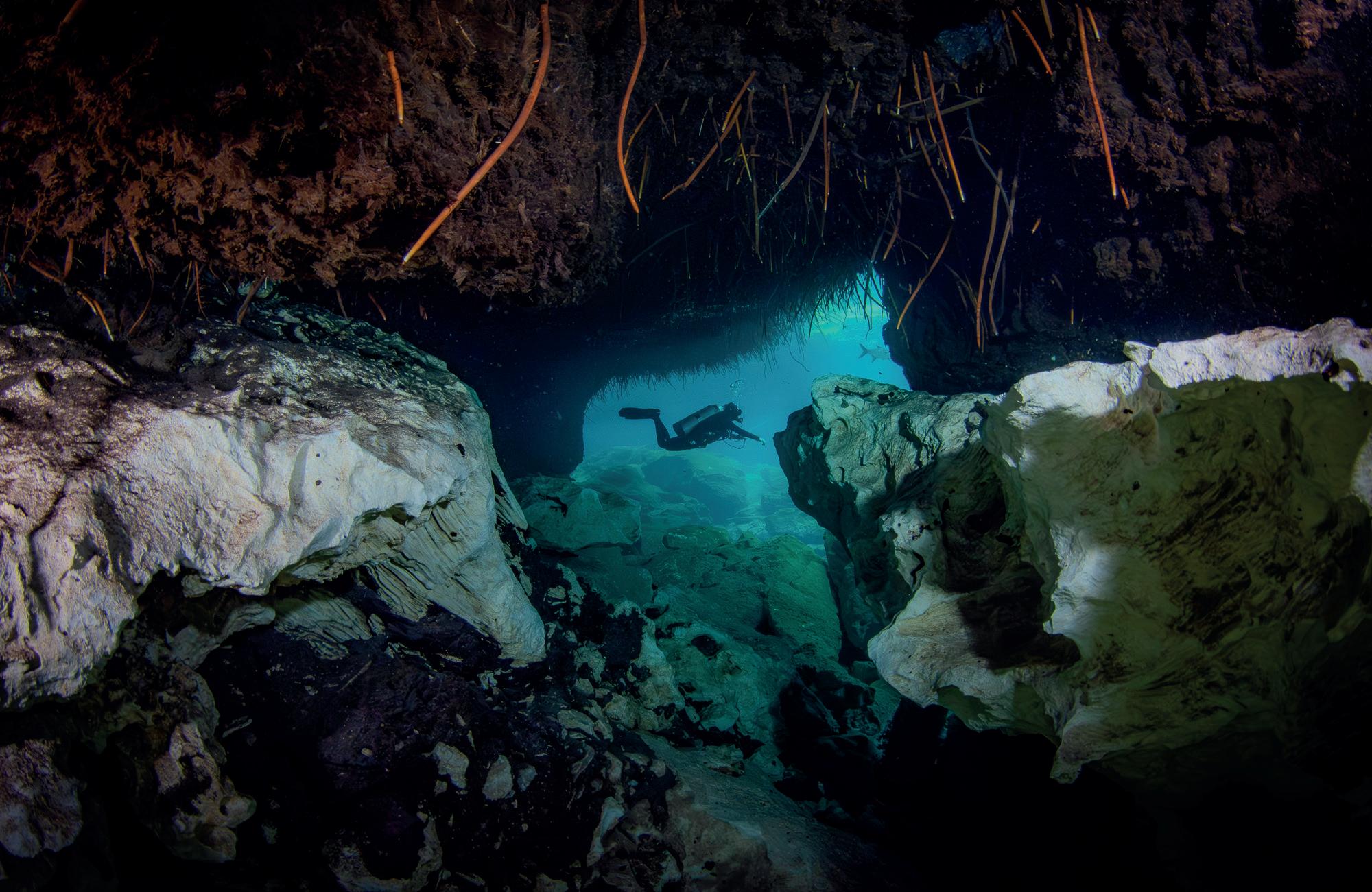
Have you ever swam beneath the roots of a forest? The stone archway has long since collapsed!
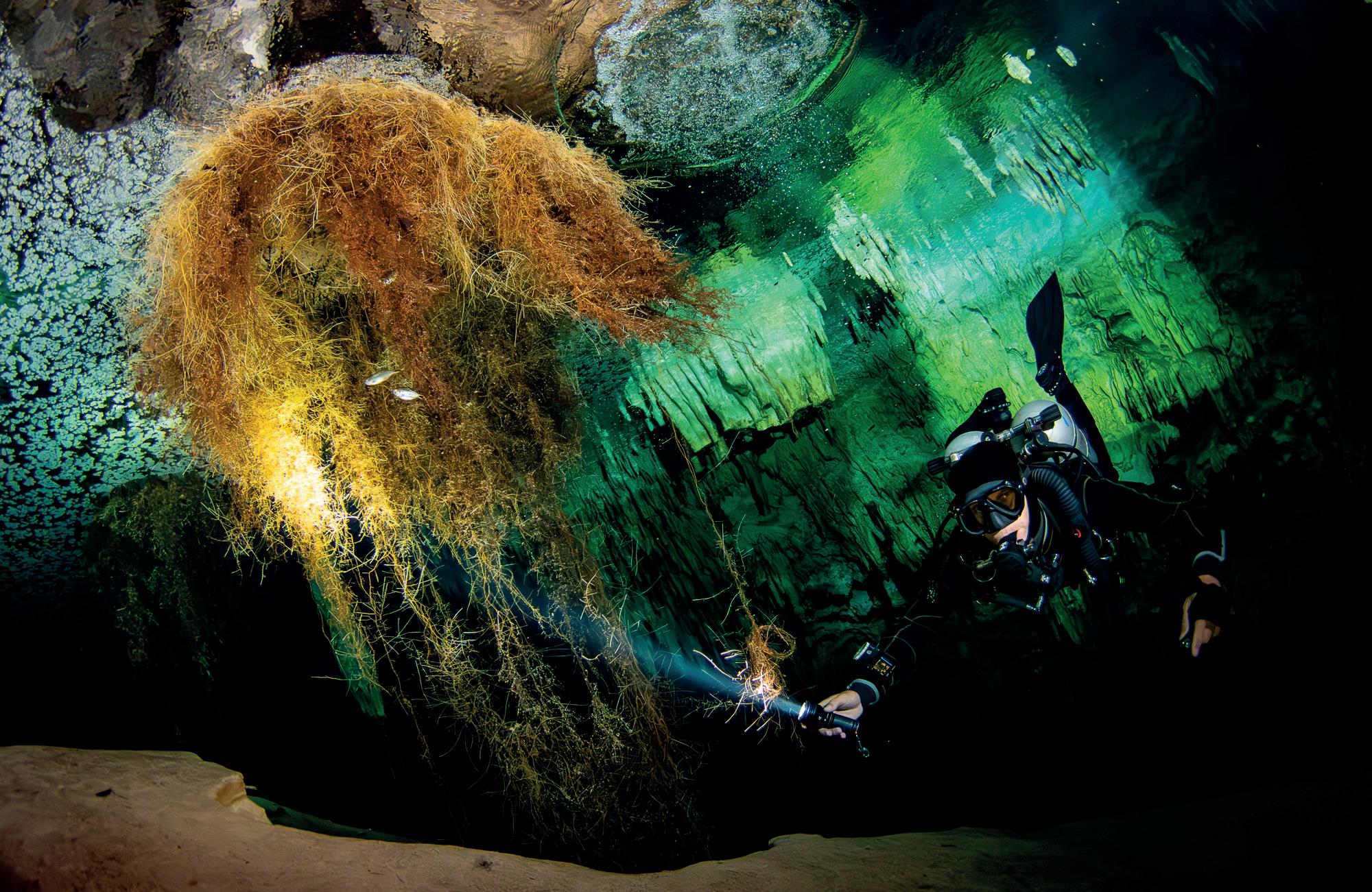
Krzysiek knows exactly where and when to position himself for the perfect shot.

dile’s diet mostly consisted of small invertebrates – unless it had grown to three meters long, like the ruler of this cenote. Its appetite for larger prey grew proportionally with its size. Their gazes met, one full of hunger and the other of terror, weighing the odds of confrontation in a split second. The reptile didn’t attack immediately – never in its 40 years had it seen such a hairless monkey. It hesitated. Ximp acted instinctively, like true prey – he began to flee along the ledge. At one point, however, his hand lost its grip on the rough limestone surface, and he was swept into a surprisingly large cavern by the current. He encountered a tunnel that could be a dead end, a refuge, or an entrance to the world the Elders spoke of. According to them, souls could use these paths to reach the underworld. Between the two evils, the crocodile's teeth were the more immediate threat. Taking several deep breaths, he disappeared into the darkness.
This time, the crocodile failed to taste human flesh – the current carried the boy to a place where the predator dared not go. Ximp felt as if he were being borne like a chief among his tribe. Around him, sharp stalactites and stalagmites jutted like spears. Between them, he saw pale, eyeless fish. Was this the underworld? In some spots, the cave ceiling vanished, and countless jungle roots stretched toward his face. Stray sunbeams pierced the mangrove forest canopy, forming cascades of light. Life reminded him of its presence as his air supply dwin-
dled, but the current slowed, and he surfaced in an underground lake. Was this still a dream? He took a few deep breaths and dived again, wanting to touch what fascinated him. He saw his reflection in the water’s depths! The image blurred as he felt the water become very salty. He promised himself that he would share all of this with his tribe if he found a way out. A distant, rhythmic sound reached his ears, like hundreds of drums playing far away. The air smelled of salt. Perhaps the great water had drawn him to it. That was where he was supposed to meet Rexina. He pressed on toward his destiny.
If you want to see everything Ximp did, visit Mexico. You don’t need a cave diving license, but you do need good buoyancy, a skilled guide, and an open mind to appreciate the beauty and biodiversity of the underwater gardens leading to the Mayan underworld. For aquarium enthusiasts, diving among mangrove roots and observing countless guppies, colourful cichlids, turtles, and catfish. Unfortunately, crocodiles are few and shy of humans; the specimens in the photos were about 1–1.5 meters long.
I owe seeing all these wonders to the excellent guides and models: Gosia Pytel from Polish Corner and Krzysztof Sienkowski from Cave Blue Diving. Thank you!
If you’d like to join me in exploring the locations described and this natural paradise, feel free to reach out.
I'll come back there again...
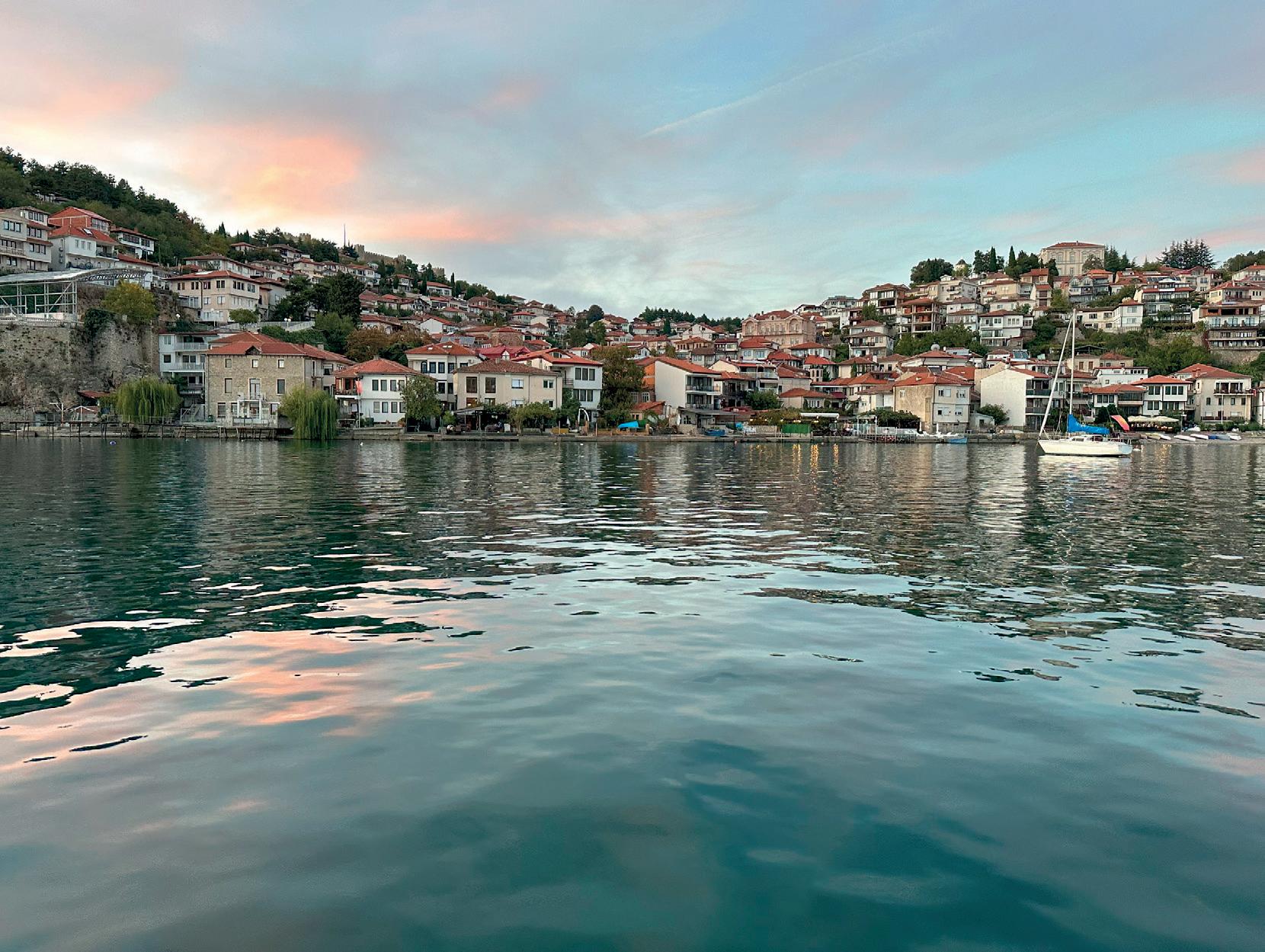
For me, Macedonia is a land of contrasts. On my first day there, I seriously contemplated returning home, but by the very next day, I was already considering extending my stay. It's a place where impressions shift rapidly, keeping you constantly intrigued.
We started our trip in Skopje, mainly because there are no direct flights from Poland to Ohrid outside of the tourist season. As a result, we decided to spend a day exploring the capital of Macedonia. If someone had brought me to this city without telling me where I was, I probably wouldn’t have been able to guess the country! The cultural mix was dizzying – on the one hand, the Ottoman district on the right bank of the city, with Turkish elements like the

stone bridge dating back to the 15th century that connects both banks of the Vardar River; on the other hand, modern buildings constructed after the great earthquake of 1963 that destroyed 75% of the city. Then there’s the Cyrillic alphabet, which is the official script here, making my head spin a little. I must admit that Skopje is also a capital of monuments, with countless statues, some of which are truly impressive in size. I kept wondering whether I felt awe or kitsch, but I suspect that
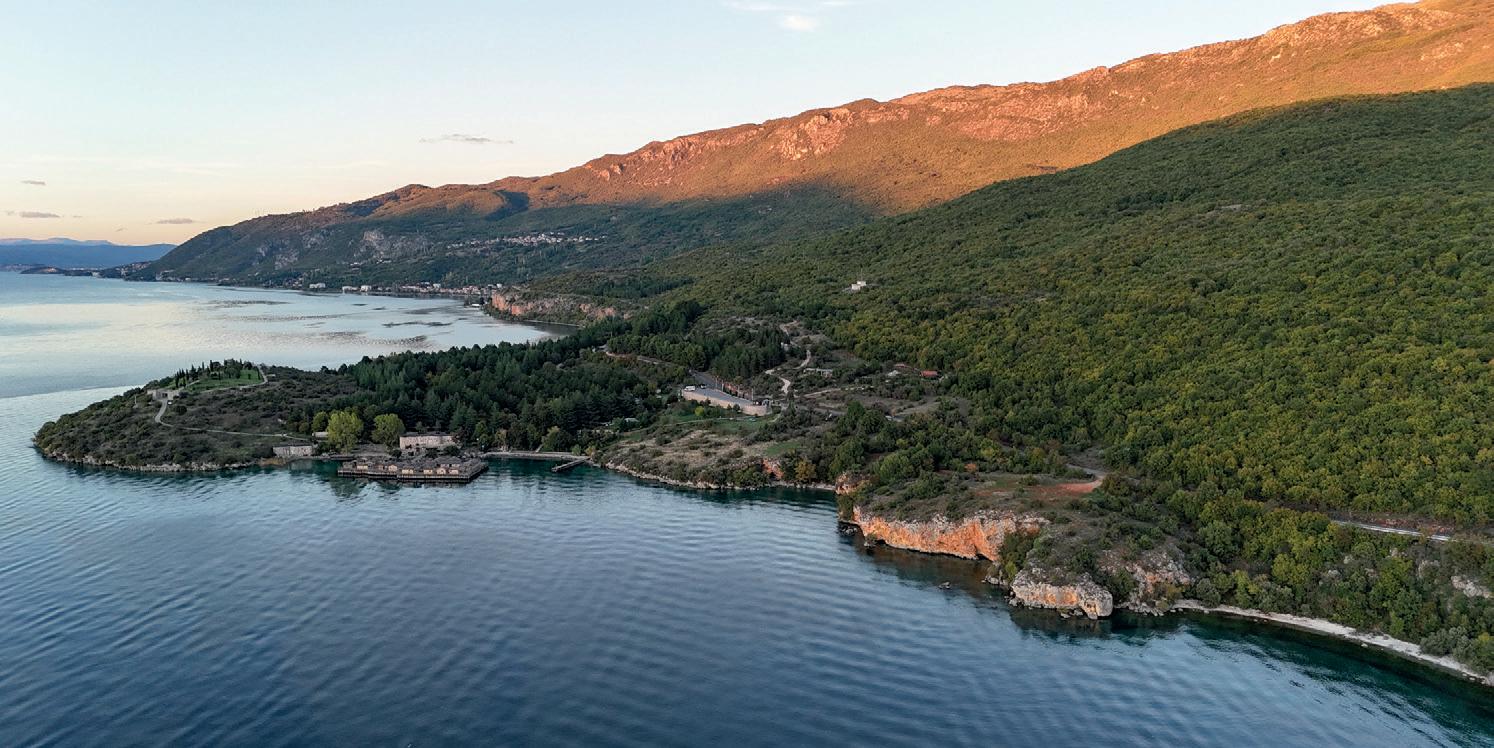

this duality of feelings is something many tourists experience. What I easily categorized as "NO" was the shocking amount of trash. Streets, sidewalks, and parks were drowning in litter, which made the stay less pleasant. Is Skopje worth visiting? Yes – it was an interesting experience of contrasts, but staying here longer would be a waste of time, at least for diving enthusiasts. Macedonia does, however, have a very interesting offer in this regard, but more on that in a moment... ;)

We rented a car and headed towards Ohrid. We had a lot of fun paying road tolls that ranged from 0.5 to 1 euro. (Yes –you can pay in euros, even though the official currency is the denar). On the way, we visited the Matka Canyon, which truly dazzles with its beauty, although here too the path is surrounded by trash. A nice tourist attraction is the possibility of renting kayaks and rafting through the canyon. There are also boat tours that include entering caves. The entrance to the


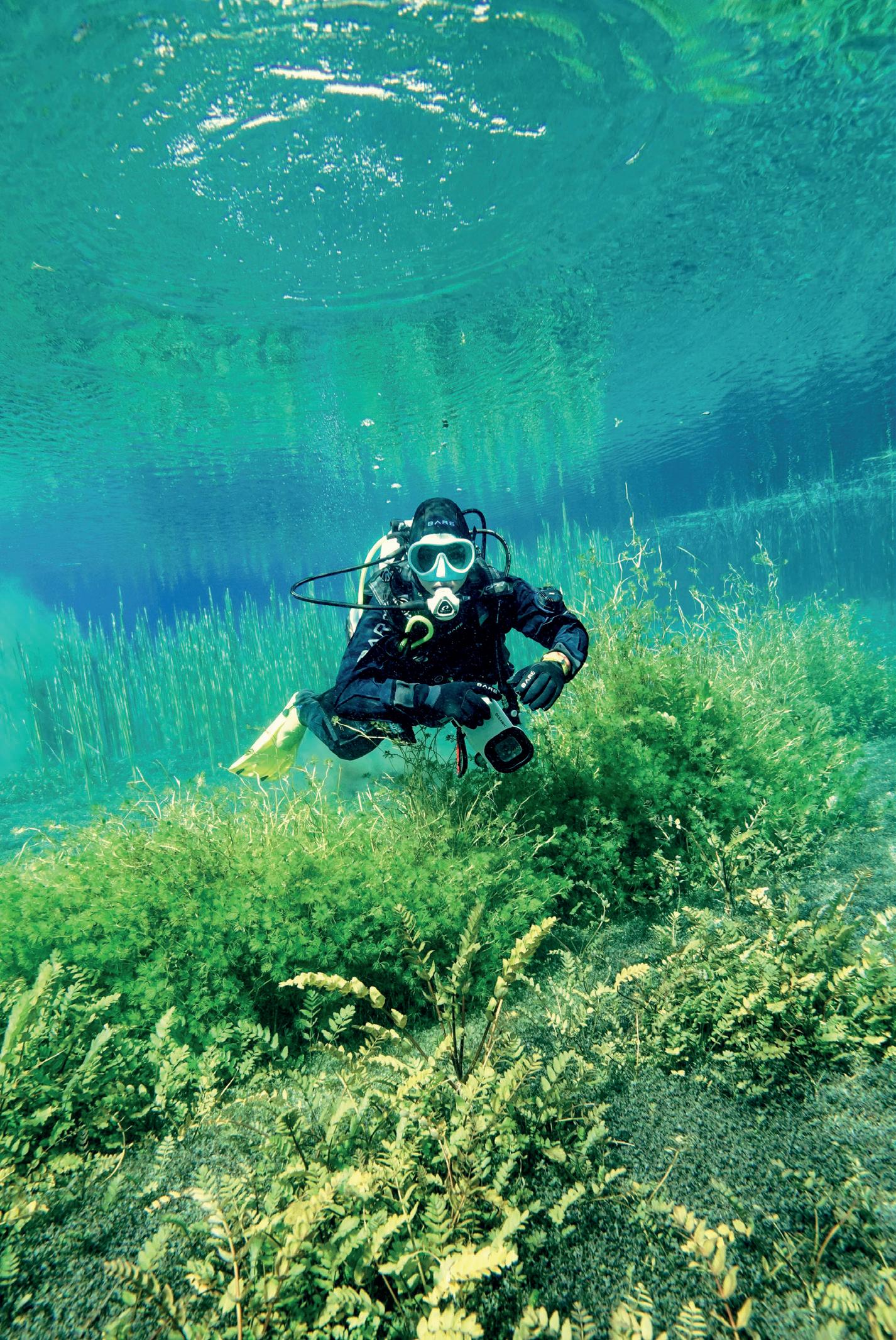






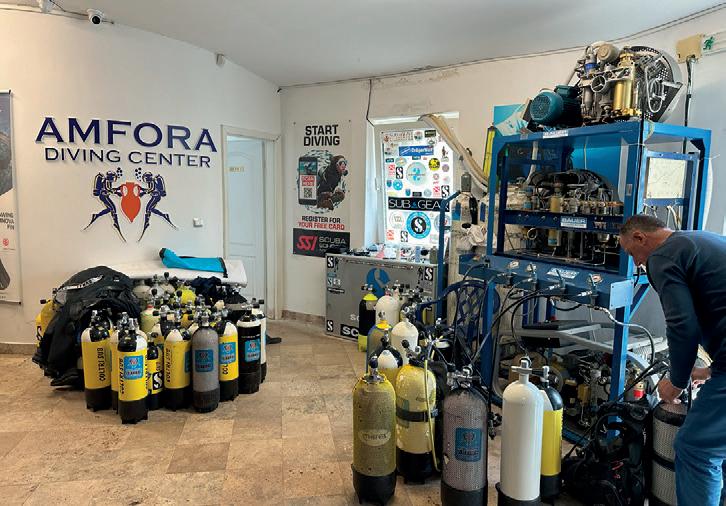
Matka Canyon itself is free, only additional water attractions are charged.
The route allowed us to enjoy the beautiful mountainous landscape. We arrived in Ohrid after dark. We were greeted by Jovan from the Amfora Diving Center, who had invited us to Macedonia in the first place. The apartments are located just a few minutes from the city center, while the Diving Center is about 12 kilometers further, right on the shores of Lake Ohrid, with its crystal-clear water and a maximum depth of 289 meters. Both the city and the lake are listed as UNESCO World Heritage sites. It felt like a completely different Macedonia from the one we had seen the day before – one that invites you to stay much longer. Right next to the Amfora Diving Center, you can notice a reconstruction of a stilt settlement – the Ploca Micov Grad archaeological site in the Bay of Bones. It is a museum complex where you can see artifacts dated from the 12th to the 2nd century BC, including bones, vessels, and tools. This left a huge impression on us, especially since we were about to see more such artifacts underwater! It was a wonderful experience. Diving among the stilts embedded in the lake’s bottom, upon which the settlement was built, was magical. On a sunny day, you can witness a beautiful play of light. The guide takes you to additional archaeological sites, including the enormous, perfectly preserved amphoras. Diving in the Bay of Bones is only pos-


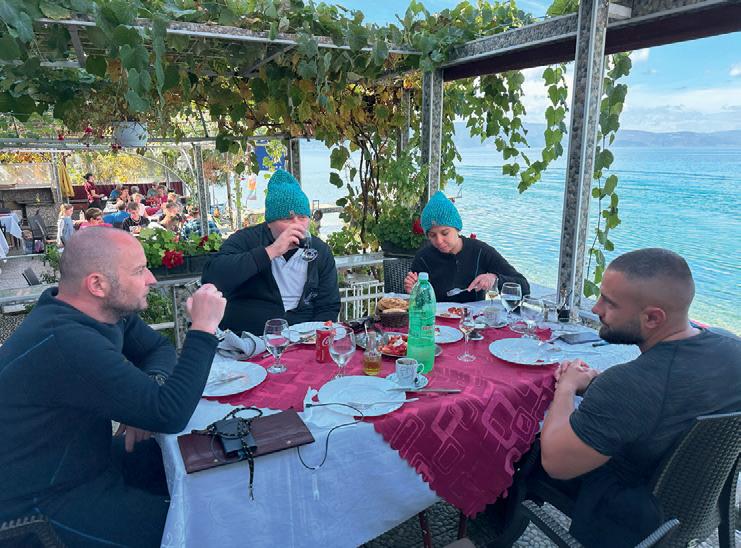




sible with the Amfora Diving Center. It's worth mentioning that, besides its amazing location, this center stands out for its excellent equipment and very friendly atmosphere. There are also excellent conditions for learning how to dive, so you can combine a tourist trip with acquiring new skills.
Lake Ohrid is very large, so we dive in more places than just the Bay of Bones! Some diving spots are accessible by car, others by boat – Amfora Diving Center has two boats. There are some very interesting underwater places for both shallow water diving enthusiasts and those fascinated by the "cold, dark, and deep" variety. I also fondly remember diving in the springs of the Black Drin River near the Monastery of Saint Naum. It was quite an experience for me, as I’m not fond of cold water, and the constant temperature here is 11°C. A dive lasting less than an hour in these conditions was a challenge. However, the views made up for the difficult conditions, as this was the most crystal-clear water I had ever dived in, and the beautiful green gardens and sun rays lighting up the area will stay in my memory for a long time. There are several nice restaurants around the monastery, so you can warm up with hot food while sitting in the sunshine (as in October, temperatures still reached 24°C). The monastery itself is also worth

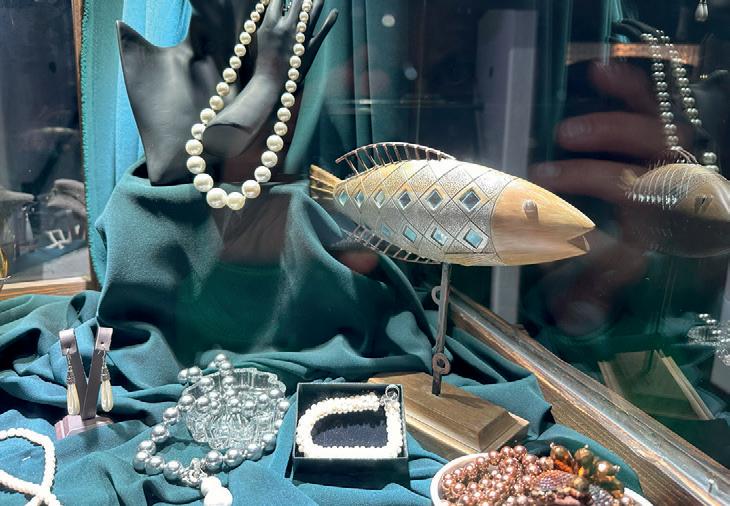
seeing. It’s surrounded by beautiful gardens where you can walk among freely roaming peacocks.
The areas around the lake are dotted with historic churches. The most iconic ones are the Church of St. John the Theologian in Kaneo and the Church of St. Sophia, but the most charming place is the area around the Church of the Mother of God Zahumska, which is much easier to reach by boat than by land.
When planning the budget for the trip, we have some good news regarding food – prices in Macedonia are tourist-friendly, with a good meal in a restaurant costing around 11 Euro, and fresh fruits and vegetables at the market for just 1 Euro. Macedonian cuisine is very tasty, rich in vegetables and various types of salads, as well as traditional Balkan dishes. A good wine or rakija will enhance your meal, and afterward, I encourage you to try trileche – a delicious local dessert that I’m already missing, or for traditionalists – local baklava.
A curiosity for ladies would be the Ohrid pearl – harvested from the scales of the plashica – a small endemic fish. Beautiful jewelry is made from these pearls, which make an ideal souvenir from your time in Macedonia. Just a little tip – be sure to check the certificate to avoid buying a fake!

Continuing the adventures from the previous article, we left off at a challenging point – the new diving season had started, but I found myself without a partner because my previous buddy had become a father. In recreational diving, changing partners isn’t a big issue since you just need to "get used to" the new person. However, in technical diving, it’s more complicated – it requires numerous dives together, meticulous planning, and, importantly, hours of conversations and discussions.
To make matters worse, I already knew my time in the UK was coming to an end, and I had one year to wrap things up and start a new chapter in Poland. Given all these circumstances, resuming the project of diving to the bottom of Dorothea Quarry seemed almost unattainable. However, fate has a way of surprising us, and in my case, things turned out differently…
The first twist of fate was a call from a friend who is an instructor. He invited me on a wreck diving trip to Scapa Flow in Scotland. You can read more about that in one of my earlier articles. One person, unfortunately, had to cancel, and after a few quick calls, I managed to secure the spot. The trip was just a week or two away, and I knew such trips usually require booking at least a year in advance. It was a dream opportunity for me! Once the excitement settled, my friend gave me the contact information of someone who was left without a buddy, whose place I was to take.
That person was Karol Lewandowski. I knew Karol by sight; you know how it goes – technical divers cross paths at dive sites a few times a year, so I knew who had canceled, who was going, and who Karol was. However, our interactions had been limited to polite "hi, hi" exchanges, sometimes discussing gear, technical innovations, or diving gossip
The trip to Scapa Flow came quickly. It was there that our dives quickly revealed who Karol really was. For a week, we engaged in technical dives, conducted decompression stops, and explored wrecks at one of the two largest wreck sites in the world (the other being Chuuk Lagoon in Micronesia). Diver opinions vary – some prefer the dark, cold waters of Scapa Flow, while others favor tropical Chuuk. The


truth is, to admire wrecks in both locations, you need to be a technical diver.
From the first day, I noticed that Karol was an excellent technical diver. How? First and foremost – his diving responsibility. Karol was fully aware of the risks associated with technical diving and ensured that I also understood the "rules of the game." The hours spent together allowed us to synchronize as buddies. Every dive was meticulously planned – we knew how we would enter the water, how long we’d stay, who would deploy the SMB for decompression, and when we would end the dive.
We also had our "adventures." I dropped my dive computer, which malfunctioned, so I spent the entire trip using a backup computer. Meanwhile, Karol’s wing inflator failed, leaving him unable to stay afloat on the surface on his own. Scapa Flow gave us the time needed to truly get to know one another as dive partners.
Already on the second day, we arranged to meet at the pub opposite the port where our vessel was docked. That’s where the conversations about Dorothea Quarry began. Karol was curious about the gases we had used, where we searched for the bottom, and many other details. Our evening outings to the pub became a tradition – we analyzed the day’s dives and made plans for a joint dive to Dotty’s depths.
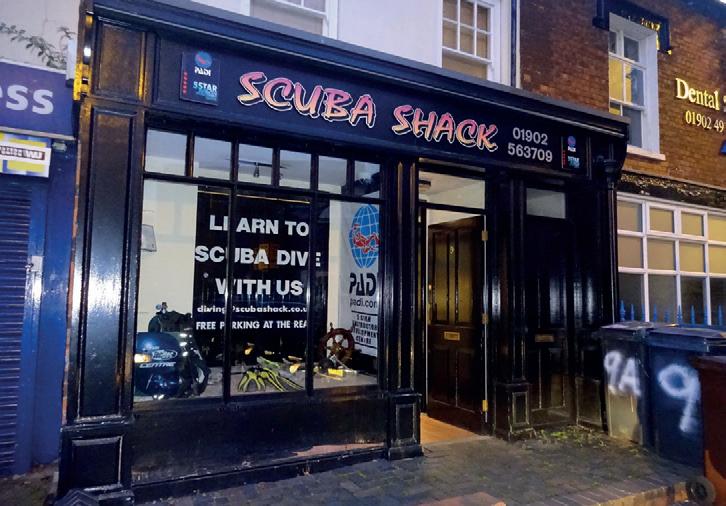
After returning from Scapa Flow, our main ambition became reaching the bottom of Dorothea Quarry. Following a week of decompression dives, all we needed was depth progression, which we systematically achieved at the NDAC Chepstow quarry, where you can dive up to 76 meters. Our dives gradually grew longer, with the final one reaching a 30-minute bottom time – quite an achievement, as the
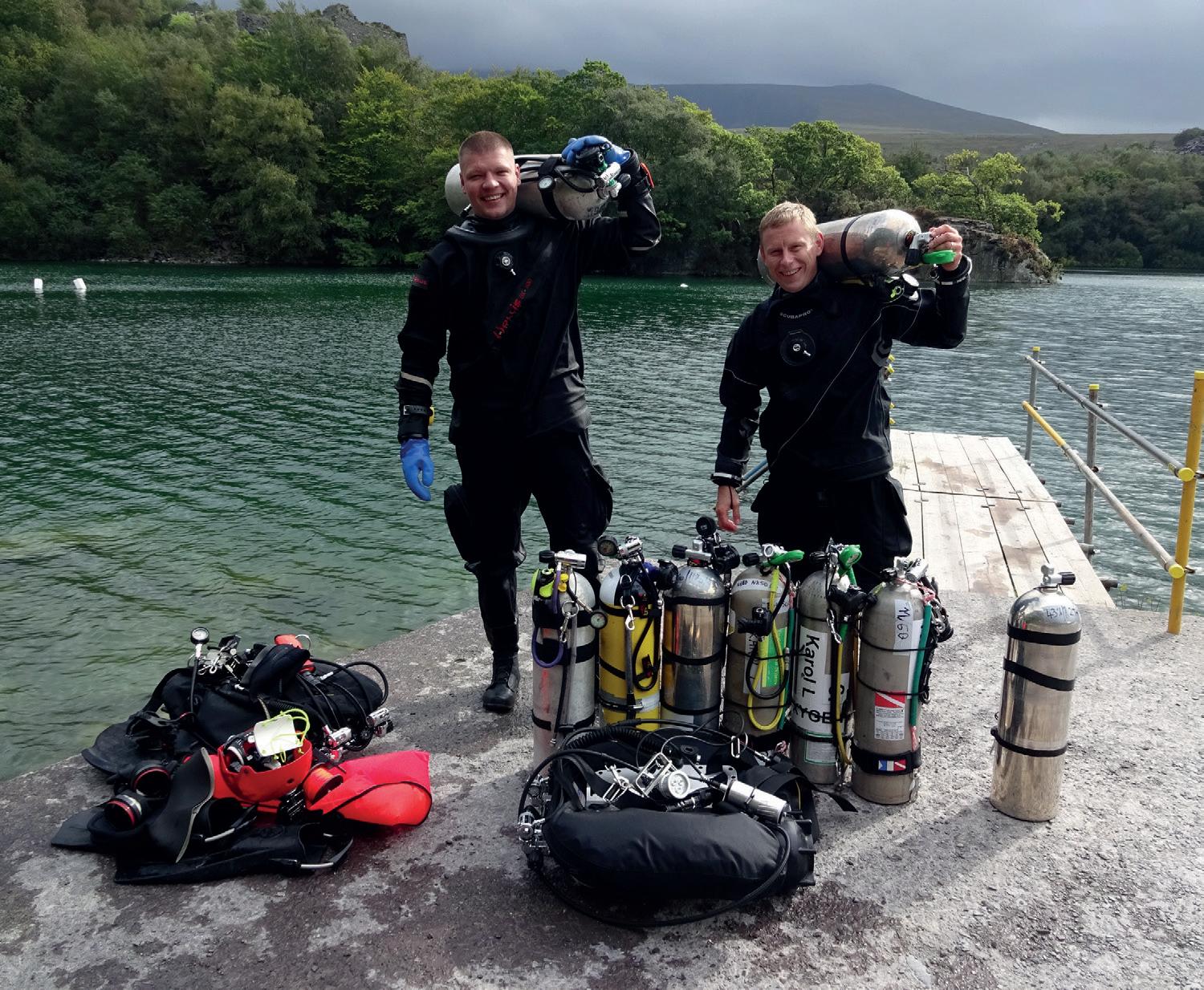
decompression after such a dive took 90 minutes using two decompression gases.
When the time came to face the queen – the Dorothea Quarry, we had a detailed plan prepared. Everyone knew their responsibilities. The key difference between diving in Chepstow and Dorothea was that at Dotty, we were completely on our own – in case of problems, there would be no one to call for help. We had to bring our own oxygen, not in small 3-liter cylinders but in two 12-liter ones. We also had to secure a surface support person, which required considerable logistics. Each of us carried a twinset on our backs and four stage cylinders. That made a total of six cylinders per person, plus an additional one with oxygen at 6 meters for safety. On top of that, we had to transport all the gear back and forth along the steep path from the parking area to the water.
The details of the dive itself and the latest updates on Dorothea Quarry I’ll leave to Karol, but I want to sincerely thank him for the invaluable memories.
Karol’s part about the dive day and the current state of diving at Dorothea Quarry
Our dive day at Dorothea Quarry began quite early – a 4:30 AM wake-up, a quick drive to a dive center near Birmingham for gas analysis (mixed especially for us by a skilled mixer friend), and then, by 6:00 AM, we were on our way to the quarry in North Wales.
The day was rather windy (as is typical in Wales), cloudy (as is also typical in Wales), and consequently cold (you guessed it – very Welsh). Essentially, no one else showed up at this remote part of the world except for me, Tomek, and my wife, Asia, who acted as our surface support. Asia bravely endured the unfavorable weather, equipped with an emergency plan and spotty cell phone reception – just in case…
Meanwhile, Tomek and I focused on hauling our dive gear from the parking lot to the water via a steep concrete ramp. And there was plenty to carry – each of us had a twinset and
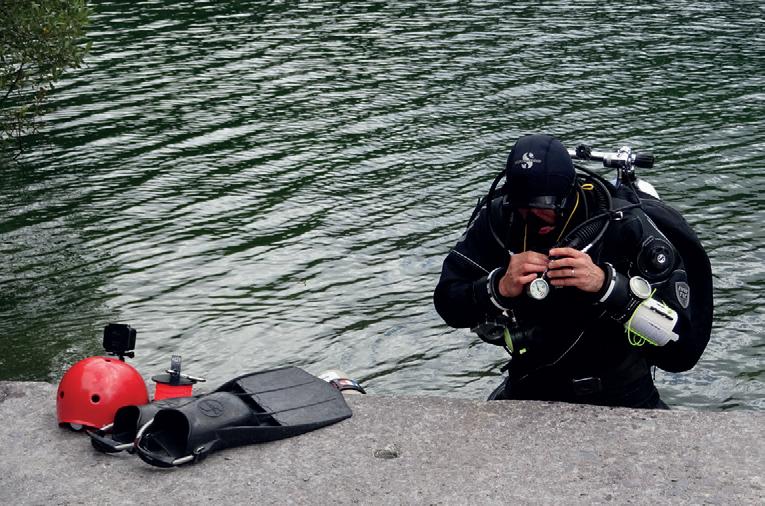



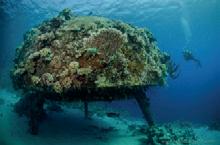


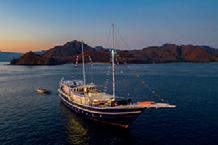



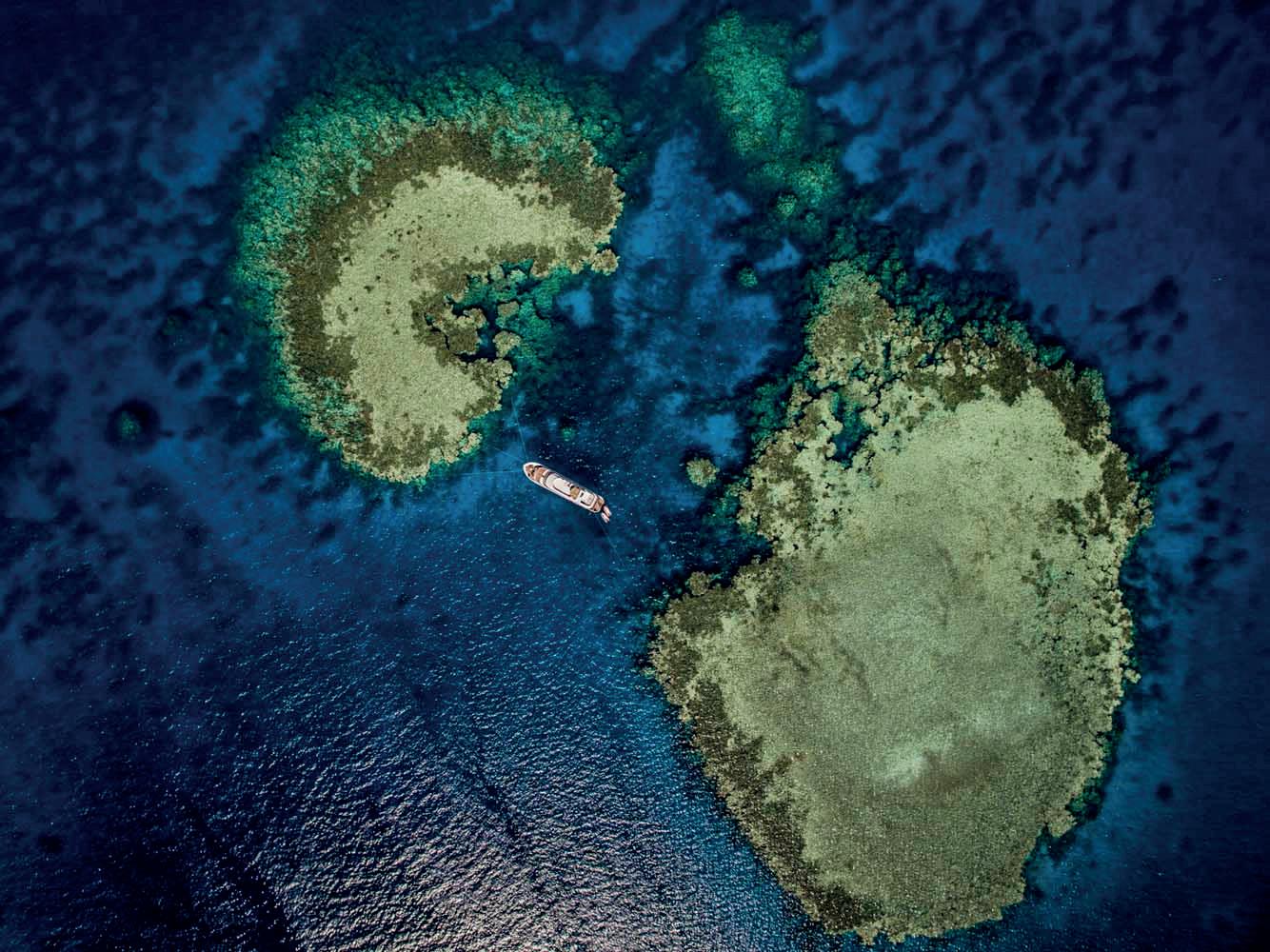

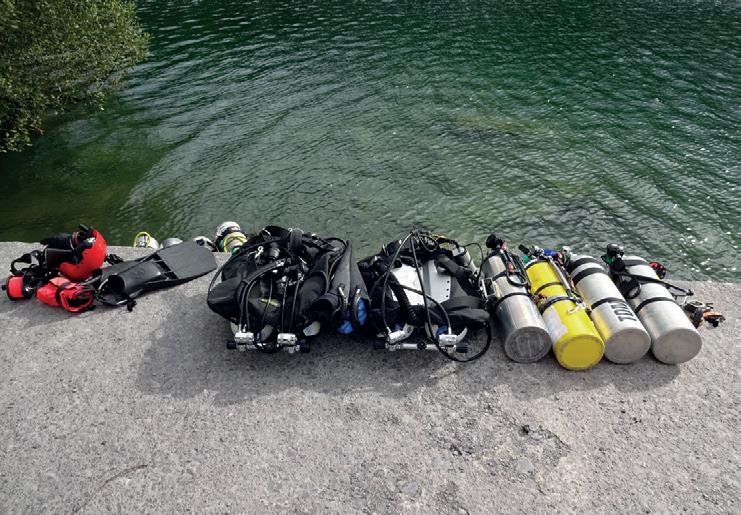

ridge transitioned into a wall, and the slope led to a semiopen tunnel at 106 meters. Tomek entered first to take a look, and then we switched places. I examined a plaque mounted inside, and after a brief exchange of excited gestures, we knew it was time to focus on the journey back – which was by no means a simple task.
We began ascending from the bottom along a carefully arranged retaining wall made of stones, passing bushes and trees protruding from its crevices. At 90 meters, we finally found the familiar, long-sought house. It turned out there were two houses! Something no previous description had mentioned... The important part was that we had the wall as our guide. We started ascending steadily, moving slightly forward while keeping the rock on our left. The depth gradually decreased, and at 60 meters, it was time to switch to our travel mix. Looking upward, I could see a faint greenish glow from particles of light penetrating to that depth – a beautiful sight, though sadly invisible to the camera.
We continued our ascent along the rocky ridge until we reached the end of the same ledge at 40 meters where our deep journey had begun. Success! Now, we had to navigate toward the shallower section near the entrance, followed by over an hour of decompression. Upon reaching a depth of 21 meters, we switched to our first decompression gas, EAN50. Moving upward

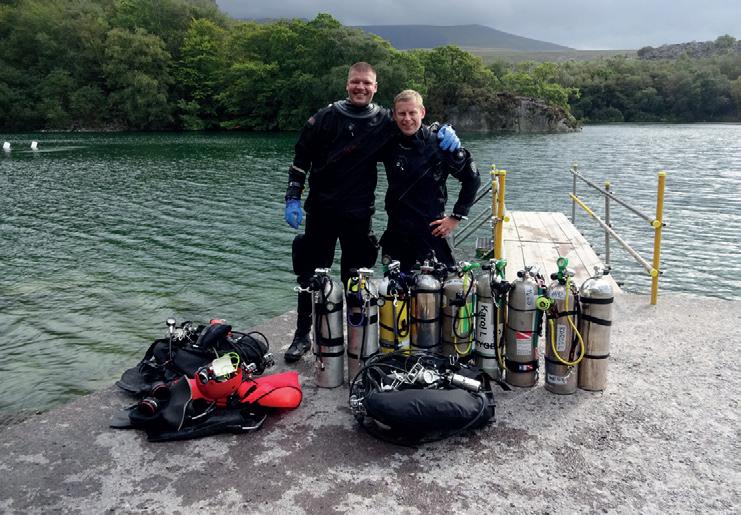
as our computers allowed, we finally arrived at 9 meters, where the stop felt like an eternity.
We were freezing – helium-based gas mixes significantly chill the body through the lungs, and the water remained a constant 6°C. At last, the much-anticipated moment came: transitioning to the 6-meter stop, where we immediately entered a warmer 16°C layer of water. The sensation was like plunging into a hot bath! Both Tomek and I shouted with joy. The dive was going extremely well – we had achieved both our navigational and depth objectives. However, we still faced over 40 minutes of decompression on pure oxygen, including mandatory air breaks.
At our final stop, we had a few sights to enjoy, like an old crane, several cars that served as deco stations, and even a few fish making appearances. Time passed slowly, but we felt fantastic. Once our computers cleared us to ascend, we followed the rule of 1 meter every 2 minutes. Such demanding dives in cold water call for great caution.
Finally, we made it! Reaching the surface, we shouted with joy and gave each other high-fives.
My brave wife, completely frozen, looked on, wondering whether our loud celebrations were purely from excitement— or perhaps a touch of madness. She certainly didn’t find it as amusing, having stood on the shore for two hours in the glorious Welsh wind.


Then came the not-so-glamorous part: gathering our gear and hauling all the tanks up the steep hill to the parking lot. With no one else willing to do it for us, we patiently carried the heavy tanks to the cars, one by one. Afterward, we stopped by a café in Bangor to reflect on our experience before embarking on a 4-hour drive home.
The memories were so powerful that even after eight years, I still recall them as if it were yesterday. Tomek, thank you for the incredible memories of our first hundred!
Dear readers, this is my final article in the series on diving in the UK. Each piece provided practical tips about specific diving locations across the United Kingdom, while also sharing advice on becoming a better diver. Thank you for being here, for your comments, and for your questions. Every interaction gives me the strength to keep writing.
Taking this opportunity, I’d like to wish you all a Happy New Year, as this is the final issue of 2024. For those who’ve had a tough year, I’d like to remind you of the first part of my article – life’s twists and turns are often unpredictable. Remember, it’s not the destination that matters but the journey. And what about my journey? You’ll probably read about it in the next issue...


DIVING IS UNDOUBTEDLY ONE OF THE MOST ATTRACTIVE AND DIVERSE ACTIVITIES AVAILABLE TO EVERYONE TODAY. EACH DIVE CAN BE AN UNFORGETTABLE ADVENTURE AND WE NEVER QUITE KNOW WHAT WILL HAPPEN TO US UNDER WATER.
Even a body of water that we know well can surprise us and the "sea creature" from THIS dive can be engraved in our memory for many years. One of my first digital photos from the popular camera brings back a smile and memories even after twenty years.
As a child, I liked to look through family photo albums. Then I decided, that I would document my moments worth remembering. Each of us returns to the events of our past with some sentiment after years. Especially if those were nice times, and the adventures, that we experienced are recreated in our heads at the sight of images. Memories come alive and we move into the closer or more distant past with a certain nostalgia.

At the time when I started photographing, and then filming underwater, the generally available knowledge on this subject was very limited and poorly available, and the digital revolution was yet to come. The time from the moment you pressed the shutter button to seeing the effect was long and expensive. There was no way to correct your mistakes and improve the effects on an ongoing basis. This,, which is everyday life for us today, twenty years ago was a dream. Each of us carries at least one digital camera in our pocket, and some have better lenses and sensors in their mobile phones today than the best digital cameras of that time. That's why I'm so surprised by, that today, when every second person takes a camera, sports camera or phone in a case with them, their photos and videos are so poor.
The camera does not take photos and does not shoot videos! It is you who takes them with your camera. You can have the best equipment and make poor footage, or you can make great videos and create amazing images with poor equipment. It is impossible to create good shots without understanding the principles of the art of underwater image recording.
It is surprising, how often I see divers who, without any consultation with their instructor, spend several thousand zlotys on the best, of course in their opinion, equipment. In this article, I will show you what are the hardware options, when you want to start playing with photography and film, and I will try to convince you, that you should start with a course in photography or
underwater filming, so as not to waste time and "immediately" achieve satisfactory results.
This can make your head spin. I will not give you a specific choice, but I will present the options and the most popular solutions. It will depend on you, Dear Reader, how you use this information.
A great solution, because you can also use it for other sports, like skiing or cycling. Like most things "for everything", it is... small and compact, does not take up space in the already large, diving luggage and can easily be a companion on every dive. Very good image stabilisation, great colours when snorkelling and at shallow depths. The possibility of taking up to several meters without the housing and to greater depths, when closed in the housing, is convenient. Expanding with colour filters gives you options to adjust the colour scheme and embellish the material. Dedicated applications make it easy to process our work immediately after taking, out of the water even without taking it out of the case and publishing, for example, in social media. Relatively cheap, because the cheapest models can be bought from a few hundred zlotys to three thousand for the high-end ones.
And that's "it" of the advantages. Before use, we have to set it up and we have no influence on any parameter after closing it in

the case. If we chose, for example, recording in 5K and dolphins are coming and we want to make a long video, then there may be problems with heat dissipation. The cameras heat up quite a lot, and when closed they heat up even more and can freeze and that's the end of using it until you take it out of the case. Quite quickly we will notice, that the automation cannot cope with the small amount of light at slightly greater depths and we will face the problem of installing lighting. Due to the standard wide angle of lenses in the, webcam we will have to choose whether we will install a flashlight with a very wide beam angle (dedicated to video, for example GRAL MARINE KX mini VIDEO) or we will use a normal flashlight and we will have a "burnt stain" on the videos. A nice solution are hybrid flashlights, which have been designed for normal use, but have a video option, like TECLINE TECLIGHT, which, when turned on the LEDs, perfectly illuminates the recording space and does not "burn" the hole even when illuminating close frames.
In my opinion, the most practical solution for beginner creators. The better your phone, the better cameras and lenses it has. I will emphasise: the lenses – plural. This is one of the most practical solutions; you go diving with two, three, and even four different
lenses. You can do an ultra-wide frame with a wreck and a diver, and a moment later order a centimetre snail to show its horns. You go out and you already have all the material on your phone, so you don't have to download it, you can immediately enjoy it and share it with your diving partner. I personally am an iPhone user, so from the first touch I was delighted with the OCEANIC+ case dedicated to this brand. In addition to the great application, that can correct colours,it has a unique function and also turns into a diving computer after buying such an option, for example for a week of trip. In one case you can have two devices, and when in two years we will get the latest version of the phone, our creative possibilities will also automatically increase. Of course, users of other phones can also find solutions for their equipment. A characteristic feature of this solution is an attractive price, we will not spend more than three thousand zlotys.
I would not be myself, if I didn't see defects. By putting the phone in the case, we cut ourselves off from the outside world (it needs to be switched to air plane mode). Using the camera is battery-intensive, so you need to have the right level of battery charge before or put the phone in the case for the "last" moment, which is never conducive to the safety of the equipment. Of course, the equipment will develop its full capabilities only with lighting, but more on that later.

Most often, we decide on this solution after learning about the prices of pro cameras. We come to the conclusion, that we will not spend that much, but we want to have "something" better. A camera with a built-in lens is relatively cheap, the case for it also does not kill with its price. We have access to all camera functions, we have influence on the exposures and we can decide for ourselves what to change. A very good solution for people, who do not want to "sell a kidney" to buy photo equipment. We have a variety of expansion options, connecting flashes, constant lighting, mounting lens caps to expand the field of view or macro. We will spend from a few, to several thousand zlotys on such a solution.
The biggest disadvantage of this solution is that when buying it, we have an appetite for more. We look at photos in newspapers, catalogues or in social media. And we are not satisfied with the effect. The most important thing in creating material is always the lens and compacts will NEVER have really stunning lenses.
A camera with interchangeable lenses in the housing
It's an uncompromising choice. Giving unlimited possibilities and today cosmic quality of recorded material. It is worth thinking

long and hard before choosing a system and carefully check the possibilities. Because the camera, even THE most expensive and dreamed-of one, is ONLY a small part of the set. You need to attach the lens to the camera (depending on what photos you want to take). In my opinion, the minimum set is ultra wide angle and macro. And if you have already become the owner of a fancy highend camera and at least two lenses, not much cheaper then the camera, then you have the cheaper part behind you. The casing is always dedicated to a given model with all functions available from the outside. You have to look through something when making professional materials, so there is either a viewfinder or an external monitor. A suitable port is mandatory for each lens. Just add arms, flashes or fixed lights, cables... and the set is ready. At this stage, it is worth considering the operating depth of the equipment, for example, SEACAM supplies tested equipment up to 80 m as standard, but it can be ordered in versions up to 200 m. Does such equipment have any disadvantages other than the price? Yes! It is big and heavy. Which is drastically annoying in transporting it. You will have to get used to controls at all airports. Lug it on and off the dive. On a small boat or pontoon, you will not cuddle up to your partner, but to the equipment. And you'll spend hours assembling and disassembling this set every time. But... it's worth it.

Too much? Do you get a headache from options? What to choose? And we didn't even start to tell you about how to use this equipment. I don't have to convince you that the techniques of using each of these equipment will be different, although the principles of underwater photography are THE SAME for all this equipment. Therefore, just a few points that are to convince you, that you should start with training, where you will get equipment from your instructor, who will show you how to prepare it for diving, will discuss with you the photo plan, what frames you should take, will show you tricks on how to improve the photos at the stage of taking them, will discuss them with you after the dive and will correct mistakes. You will have the opportunity to discuss your material and correct mistakes on your next dive. At this stage, you will probably "play" with more than just one solution and you will have a chance to form your opinion. You will be surprised in a positive or negative way by the effect of your creativity. Without a doubt, it will be a unique and interesting adventure. You will learn about many issues, that you were not aware of or have not paid attention to so far.
Someone once said that if you dive and your diving computer has not broken down so far, it is not because that you have such a good computer. You just don't dive enough. The same applies to photo equipment. Checking it very carefully will become a mantra repeated before diving, otherwise it will hurt to flood it. It is worth making sure, that we properly insert the
equipment into the housing and lubricate the O-rings. I have seen many times lubrication of O-rings without substantive preparation... almost as often as the same equipment flooded afterwards. I recommend learning it from a professional. This is the "cheap" option.
Until now, you thought that you have coped with buoyancy well. Your first dive with a camera or camcorder will quickly make you realise, that ... you haven't. To record a film or a photograph you have to be EXACTLY there, where you should be, to the centimetre. And you have to move around with your hands full. So if you haven't yet mastered hovering in the depths in any position, add various variations of the "helicopter" to your list of things to catch up with, i.e. turning in place and swimming backwards.
Water absorbs light, specifically the colour part of its spectrum, the most attractive one, i.e. red and orange. You have probably already seen such a graph and you know that at 5 m there is no more red. You don't care about it, after all, you bought the "best" flashes (flash or fixed flashes don't matter). But your materials are still not colourful. On the surface, when you want to photograph the whole football team, you simply turn up the power of the lamp. Under water, the power of the lamp will not matter, colours will fade anyway. The distance from the object is crucial. Those five meters for red mean that the subject you are

photographing cannot be more than two and a half meters away from you. Because the light has to reflect and come back, i.e. cover five meters. You already have the colour, but there is fog and white spots in the photos, even though the water is crystal. This, in turn, is the reflection of light from the suspended solids in the water, you need to learn how to set the lightingso that the camera lens does not see it.
When framing objects underwater, every centimetre counts. If you think that you are close then swim even closer. Great, my congratulations, now GET even closer. With simple cameras and sports cameras, and phones in cases (of course equipped with external lighting) you will get the best results when you are a maximum of fifty centimetres away from the object that you are aiming at (of course equipped with external lighting). Learn to swim silently and stop in front of object, without picking up sediment. But it is equally important , as you sail away, not to destroy and massacre with your fins the delicate underwater life.
As a photographer, filmmaker and diving instructor, owner of all of the above equipment options and many more, I advise you, Dear Reader: Start by asking your dive instructor for advice. Even if they themselves are not specialists in photography,, they have already done dozens of dives with photo equipment. They will help you prepare for the start of photo dives, improve your buoyancy, and teach you additional techniques. And if the instructor decides they are not able to help you, they will certainly guide you to one of their friends , who specialise in this subject. It is worth spending some time and acquiring knowledge on a photography or underwater filming course before you lose money on equipment, that you will not be satisfied with and that will not meet your expectations.


Text and photos PRZEMYSŁAW ZYBER
Underwater photography is a very specific type of photography. In fact, apart from cropping, other knowledge related to camera settings and lighting has little in common with traditional "land" photography. In order to create a photograph that will hold the viewer's gaze for longer, a number of conditions must be met.
Not only a beautiful place, a properly built frame, the right choice of white balance, i.e. colours, a mood painted with light...
One of the key roles is played by the model, i.e. the character playing the main role in the photo.
What secret knowledge ;) and skills must the model have to make the session effective, fast and, above all, stressfree?
This piece of water is mine :)
Every photographer has their own style of work. It has been known for a long time. Some go wild, working as reporters, others only in shallow water, so that you can quickly emerge while discussing the structure of the frame. A lot also depends on what photos are to be taken.
I usually do sessions during diving trips: in the sea, mines, caves... We usually go down for specific frames. I'm not a fan of "impersonal" postcards. What I love is to photograph a model against the background of interesting places such as wrecks, reefs, or flooded corridors of caves or mines. I have already gone through more than one such session and I have a few observations.
And who is on the same page with this topic? Let's start!
The Beginning...
Just like before each dive there is a briefing (discussion of diving), before the photo session we also discuss what we will do and what effect we want to achieve. I assume that a mod-

el that is not surprised, that knows what to expect, is calmer and relaxed, and you can see it immediately in the photos. Of course, if you still don't understand something despite discussing everything at the briefing – don't hesitate to ask underwater. However, it is best to ask about everything before diving underwater. Remember...
Since it is impossible to talk underwater, it is best to discuss all issues regarding symbols, gestures and signs before entering the water. Any misunderstandings immediately come out underwater. Diving time is limited due to a specific amount of breathing gases, no decompression time or long decompression, temperature, batteries powering photographic equipment, or heating. A model that knows its role and follows the photographer's instructions gives you the opportunity to take better photos in less time.
I have already interrupted a session twice due to a complete lack of communication and lack of understanding of the signs discussed in detail earlier at the briefing. Therefore, be alert to the photographer's messages, even though looking straight into the lens is not desirable, as it distracts the viewer. You can then overlook other qualities of the photograph in the back-
ground. Therefore, despite looking away, it is good to maintain focus in order to react quickly. Believe me, there's nothing more frustrating than not communicating with a model.
"I'm blind! I'm blind! Tell the truth! Will I ever play the violin again?"1
But seriously. Yet another obstacle to communication is lighting. I often have to treat the model to a huge dose of light to keep them lit. And because I only use video lights, I can't be seen behind the glow of light and gestures can be imperceptible.
In dark places like caves or mines, to bring the model out of the darkness, a powerful lamp shines from behind the model. In such a situation, it is also difficult to make contact due to bedazzlement. That is why it is so important to discuss these situations at a briefing.
In order for the session to run smoothly and quickly, the model should have good skills.
The basis is a fixed hang. When building the frame, the photographer knows where the model must be in order for the photo to maintain the canons. A model that moves all the time, not controlling their buoyancy, makes it very difficult to take photos.
1 I couldn't resist. Do you remember where this quote comes from?


The ability to swim backwards (reverse breaststroke) is very useful. Most time is wasted when the model floats in circles, making subsequent attempts to position themselves in the right place. The helicopter, i.e. the ability to rotate in place, is also a very useful skill when posing.
The model's clothing is also important. Bright, bright colours are perfect for sessions. I love photographing models whose wetsuits or drysuits are yellow, orange or red. They are definitely more visible in the photo and exposed against the background. It's hard to photograph a person dressed all in black. Let's take an example – a black diver in a dark cave. It takes a huge amount of light behind the model to bring them out of the darkness. In addition, the photographic equipment itself is much better at focusing on bright, contrasting colours.
The ability to hold your breath for a moment so that the bubbles do not cover the face is also welcome. Of course, hold-
ing your breath must be associated with maintaining neutral buoyancy.
Because the exposure time of the sensor should be extended in dark places, dynamically flying bubbles are out of focus and usually overexposed. Therefore, the time on hold of breath allows you to get rid of them from the frame. Of course, the best solution is a rebreather, which completely solves this problem.
We know that the photo is an evidence. When posing, do not allow elements of diving equipment to be incorrectly arranged, tangled or sticking out. It's hard to look at photos of a sidemount with hanging or protruding cylinders. Let's position the regulator in your mouth correctly so that it does not come out diagonally, distorting your face. Flashlights should not hang, regulators in the right places, blood pressure monitor attached, not hanging. The hoses on the cylinders properly cleared, and the hood does not form into the crest. Unfortunately, all such shortcomings will be visible in the photo.

Before your dive session, take a few quick tips!
don't take the regulator out of your mouth, because it looks daftly, not cool at all (unless you agree with the photographer that you are doing this type of session), do not position yourself vertically, this is not the correct position during diving (except when it is absolutely necessary, because, for example, you are diving with a herd of sharks and this time it will be more beneficial for health and life not to maintain the perfect trim :),
—don't wave your hands, because the photo will come out blurry and it doesn't look good in the photo,
—don't spread your legs wide, you'll look like a frog :),
—don't look into the camera unless the photographer asks you to,
—don't shine a flashlight at the camera,
—pay attention to the photographer out of the corner of your eye,
—hold your breath while maintaining neutral buoyancy,
—bring your legs and knees together and take a position to breaststroke,
—Hold a flashlight to keep your hands occupied.
—Relax and enjoy the moment!


The moment I saw the poster designed by Andrzej Pągowski for 2024, I knew this was the year I’d become a guardian.
Though, truthfully, I’ve been one at heart for years— mainly underwater—this year, I had to channel my inner Texas Ranger.
This year, we organized clean-ups in various locations across Poland.
As the coordinator of underwater clean-ups, I focused on what remains unseen – known only to divers. Hundreds of certified diving volunteers suited up and descended into the depths to retrieve waste from the bottom. Many of these items are discarded accidentally, but others are intentionally, and often thoughtlessly, thrown into the water – a behavior that we cannot excuse.
Thanks to the informational platform provided by Perfect Diver Magazine – a partner of the Nasza Ziemia Foundation – many divers learned about our initiatives and joined in. Some even organized their own cleanups under the patronage of Perfect Diver and as part of the Clean Up the World Campaign.
Our efforts, and the way we showcase them, have a tangible impact on education. Anyone who wants to can join our mission and dive with us to recover waste.
Many divers meet for the first time during underwater clean-ups, and some participate in several events throughout the season. This year, we added new locations to Poland's underwater clean-
up map, including Hel, the "Malinka" reservoir in Zgierz, and Lake Białe in Skorzęcin. The largest turnouts this year were at Dominickie Lake in Boszkowo, Lake Niedzięgiel, Lake Białe in Skorzęcin, and, of course, our grand finale at Lake Kierskie in Poznań.
In practice, a diver prepares by putting on their gear: an air tank, buoyancy control device, regulator, fins, mask, and snorkel. They also equip themselves with gloves, a knife, a flashlight, and, of course, a necessary mesh bag for collecting trash.
As Perfect Diver, we conducted reconnaissance this year to identify water bodies and areas of illegal dumping. Unfortunately, these spots are often near swimming areas (piers), fishing stations (corn cans), or intentionally hidden – out of sight from land.
This year’s finale unfolded in an excellent atmosphere. Nearly 90 divers and numerous diving boats (from Mistral Poznań, WOPR, and Scuba4) enabled us to cover the entire shoreline of Lake Kierskie. The central hub for trash collection and diving operations was Parkowa Beach. In addition to divers, land-based teams joined the clean-up efforts. Unfortunately, the sheer amount
As every year, at the end of October, the team at the Nasza Ziemia Foundation began summarizing the results of this year's Clean Up the World – Poland campaign. This is a task we've undertaken for over 30 years, and each publication becomes our shared manifesto against littering in nature. It highlights both the scale of the pollution problem on our planet and the countless hands ready to take action. While the final results are still being tallied, one thing is already clear – this year’s message resonated loudly and powerfully thanks to the efforts of NEARLY HALF A MILLION VOLUNTEERS!
When we looked at the map of registered campaign hubs, we saw that our activities covered the entire country –from east to west, from the Baltic Sea to the Tatra Mountains. And, of course, the initiatives extended both above and below water!
For that, I want to extend my heartfelt thanks to all the divers who participated in the Clean Up the World – Poland campaign. A huge Green Heart to all of you!
We invite you to follow the Nasza Ziemia Foundation on social media, where the full report will soon be available. You can also visit our websites: www.naszaziemia.pl and www.sprzatanieswiata.pl
Grzegorz Mikosza
Main Coordinator of the Clean Up the World Campaign




of waste once again exceeded our expectations.
The busy day was crowned with a concert by José Torres, who, as it turns out, is also a diver. We chatted a bit about his diving adventures around the world. In Poland, however, he hasn’t yet dared to dive due to the cold temperatures and limited visibility. But with some encouragement, who knows – maybe he’ll give it a try!
By sorting waste and disposing of it properly, we contribute to protecting something priceless – clean lakes and rivers where we can dive and swim freely. Imagine beautiful, clear water without shadows of lingering trash, without the sharp edges of broken bottles, without



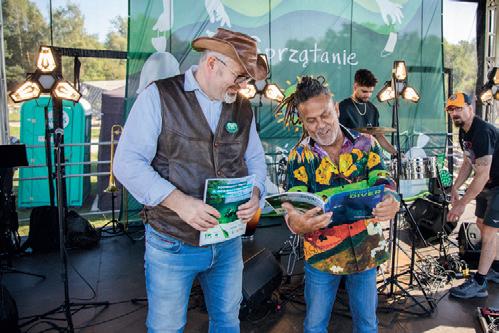
pollution from paints or toxic substances. Every properly discarded plastic bottle, every sorted can, is a step toward such a reality.
By keeping things clean and separating waste, we give ourselves the chance to connect with unspoiled nature and preserve its beauty for future generations. Together, we can ensure that the water in lakes, rivers, and seas remains clean. So, I encourage everyone – sort your waste, don’t litter, and show that you care about our planet.
WOJCIECH ZGOŁA
Editor-in-Chief of Perfect Diver Magazine Coordinator of the Underwater Clean-Up Campaign

THIS YEAR'S UNDERWATER PART OF THE CAMPAIGN WAS SUPPORTED BY:
Compass Divers
CN Dekompresja
Scuba4
Orka Poznań
Delfin Poznań
Tecline
ECN-systemy nurkowe
Nurkowysklep.pl
GRALmarine
CN Trym
Kurs Nurkowania Poznań-Diving
Team24
SUP Fest Poznań
Mistral Poznań
WOPR
OSP Napachanie

Text and photos WOJCIECH JAROSZ

A quick check of the waterproofness of the plumage, a few hurried and discreet breaths, and then a quick push with webbed feet and with a graceful leap - hop into the water! And so over and over again.
Well, maybe not "over and over again" endlessly, but until a full belly or exhaustion of stocks at a "local eatery". After all, finally you also have to take care of other things, as not by diving alone can a man live. A duck, I mean. Tufted duck more precisely. This time I will encourage Dear Readers to take a look at one of the diving ducks. It's been a long time since
we dealt with bird diving in the Perfect Diver bird column, so it's time to go back to the sources, that is, to diving. We will look at the aforementioned tufted duck (Aythya fuligula), which, next to the greater scoups, ferruginous ducks, common pochards, red-crested pochards, long-tailed ducks, eiders, goldeneyes, white-winged scoters and common scoters, belongs to the so-called diving ducks. These are
the ducks that can fully submerge under the surface of the water, and not, like swimming ducks (called dabbling ducks, Anas), at most reach the shallow bottom with their beaks. Before I move on to the things happening under the surface of the water, I will introduce the hero of this text in a few words. Tufted duck is quite a common species in Europe and Asia, because it can be found in a zone from Iceland in the west to Kamchatka in the east. In winter, birds from colder regions migrate to warmer regions. Tufted ducks occurring the northern European edges, for winter holidays migrate even to Africa, although more often to Western Europe. Many birds winter on the sea coasts, including in the South Baltic Sea, forming numerous, and sometimes very numerous flocks. In Poland, the breeding population is generally less numerous than the winter population, with a noticeable decrease in the number of breeding sites in recent decades. Fortunately, tufted ducks

are still ducks that are quite easy to meet. Of course, it gets the easier, the more often we are near water reservoirs. Not necessarily the largest ones, because it happens sometimes to meet these birds even on midtown ponds. However, you usually have to move a little away from the city to watch the tufted ducks. How to recognise tufted duck? After the style of the male, of course. He is one of those bird gentlemen who realise that classic elegance based on black and white makes the greatest impression on ladies. However, there is something that goes beyond the classic style of men's gallantry – a truly extravagant hairstyle! It is for this reason that in English a tufted duck is called tufted duck, which means a duck with a tuft or, as in polish, with a crest. A beautiful tuft of feathers adorns the male occiput, resembling a well-styled girl's ponytail. When the wind blows and the pony ruffles romantically, it adds even more
eccentricity to the bird's image. The female also has something similar on her head, although on a much smaller scale – it should be said that it is only a poor substitute for a male crest. In ducks, this is not surprising, because they belong to those birds in which males dress up to please the 'uglier sex', in this case. That is why many duckmen invest in a black tuxedo. So black that it shines metallic. The word 'invest' is not accidental here, because the black colour depends on the presence of melanin in the feathers, and melanin requires a lot of energy to produce it. So males show that they are in full strength and fully deserve to be entrusted with the role of donors of strong genes for future offspring. Bird researchers report that the presence of melanin also strengthens feathers, but this is only one of the interesting consequences of its presence, and we still don't know everything. It can even be said that there are so many issues to be solved in the
field of feather biology that scientists dealing with them will not be bored for a long time. In fact, we also don't know if a female tufted duck looking at a male sees him the same way we do. We can even assume with a high degree of probability that not necessarily. It is known that birds see much more colours than humans. Comparing the structure of the retina of the human and bird eyes, we notice that we have three types of cones (light-sensitive receptors) responsible for seeing three basic colours, i.e. red, blue and green-yellow, while in birds there is also a fourth type of receptors. They react to violet and ultraviolet radiation, so birds actually see more colours than we do. To close the issue of feather colour with an interesting bracket, I will add that often the color of feathers is not a consequence of the presence of specific pigments, but is created as a result of the refraction of light by the feather structure, which is why such a colour is called
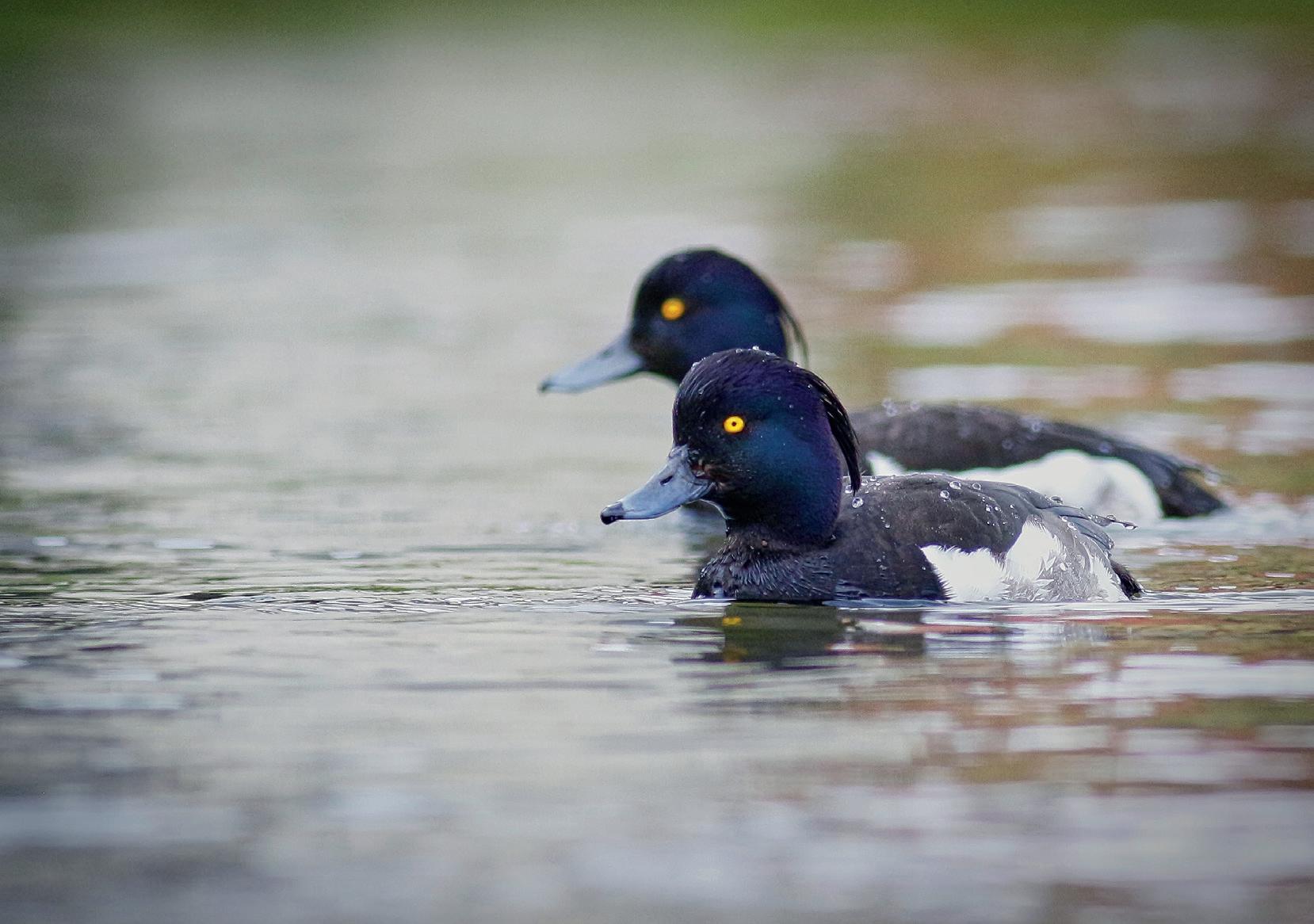
structural. This is why the kingfisher's back sometimes seems more turquoise to us, and other times very blue.
Let's go back to the tufted ducks, but let's stay with the colours. It is worth admiring the colour of their eyes, because it is vivid gold. The cousins of tufted ducks are also golden-eyed, to mention goldeneye or greater scoup.
Okay, I was supposed to go back to diving... Tufted ducks usually dive to a depth of several meters, although they can dive deeper. They stay under the surface for several seconds, although they can do longer. It was possible to determine quite precisely how they dive, because various observations were carried out on them in controlled conditions. At the University of Birmingham, for example, the frequency of leg movements during div-
ing and its relationship with the speed of movement was studied (the matter, contrary to appearances, is not so obvious), changes in heart rate during diving and several other interesting issues including oxygen demand during diving and for comparison when staying on the surface. For this purpose, special closed-air chambers were developed to accurately measure the pressure of breathing gases. The respiration of tufted ducks, like other birds, is slightly different from how we or other mammals breathe. We remember (I hope!) from biology lessons that birds do not have a diaphragm, and the active phase of gas exchange is exhalation. The gas exchange itself is double, because oxygen comes into contact with the blood twice, and at the same time 75% of fresh air bypasses the tubular lungs and goes
to the posterior air sacs. À propos, speaking of air sacs, they also have their role to play during diving. Birds must operate the volume of air in the bags in such a way as to properly set their buoyancy (in diving nomenclature it would mean: properly fill the jacket or diving wing) so as not to use too much energy for the immersion itself (here the principle of the golden mean and a kind of balance between costs and profits prevails). In addition, air bags can provide additional insulation in cold waters. After all, air is a good insulator. And why do tufted ducks dive at all? After mussels they dive which form the basis of their diet. In addition to mussels, other aquatic invertebrates also have on the menu, and in times of scarcity, they can also live on vegetarian dishes for some time.

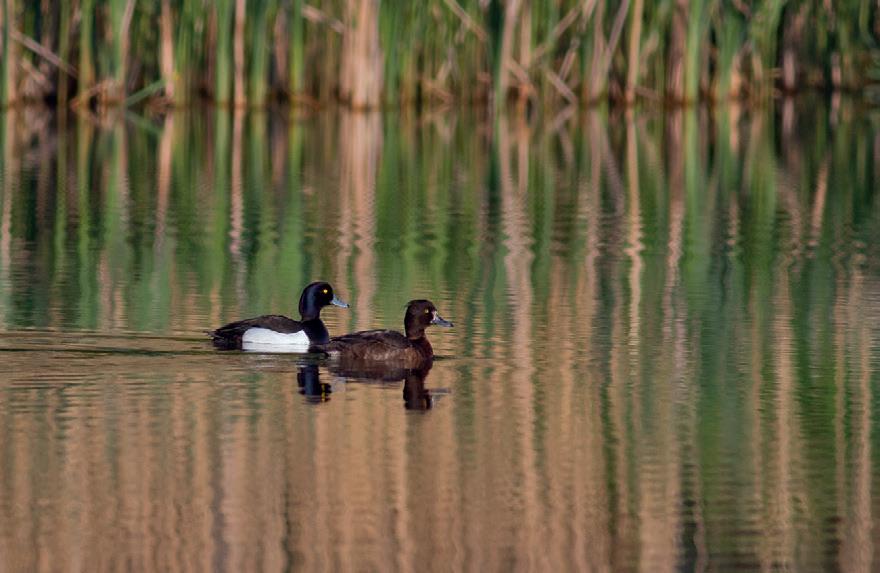


Finally, a little more about what happens when the described above image of a male captures the female to the core. Usually, courtship takes place in late winter, and the resulting couples prepare for parenthood. In fact, the female is getting ready, because after choosing a place for a nest and laying eggs, the male usually evaporates taking French leave. Apparently, he decides that there is no point in disturbing the female, who certainly knows what to do. A mother duck usually lays 8-11 eggs and sometimes tosses some of her eggs to her neighbours (sometimes even to other species!). This is why you can sometimes observe females leading more than 20 younglings! The chicks, as all precocial species, quickly leave the nest and learn to live in the company of the female. They become fully independent when they start flying, i.e. after about 50 days. They have a chance to live up to several dozen years (the reported record is 45 years in the case of a wild bird), although as a rule, they manage to struggle in an unequal fight with fate for a much shorter time.
The next time you're near water, look around for black-and-white, tufted ducks, and when you do spot them, enjoy their elegance and diving prowess!
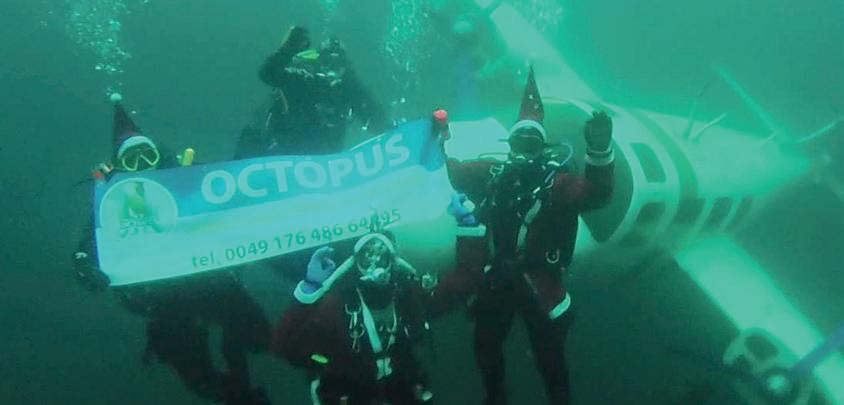



A
difficult topic
and one that is far too rarely discussed – people with disabilities. I began to notice the difference when I became friends
with Franek.
A quick introduction to Franek –a teenager, incredibly smart, and an all-around great guy.
He just started high school, has tons of interests, and is hard to keep up with. If it weren’t for the fact that he has a rare condition that prevents him from breathing on his own – he uses a ventilator all the time – and moves around in a wheelchair, he’d be just like any other teenager. Franek isn’t disabled; he has disabilities. Just a little educational note there. Now, to the point – let’s dive into some scuba stories.
We live in a whirlwind of endless activities. I’m a mom to boys in preschool and elementary school, two German shepherds, and all the kids at our diving school. At home, things are simpler with the preschooler – no homework, no extracurricular activi-
ties, and the same schedule all year round. But when we’re on trips, it’s the opposite. This year, my older son started diving with me, which is a relief compared to the younger one, who clings to my leg crying, “Don’t dive, don’t leave me!” (though after three minutes, he’s completely engrossed in his toys that we’ve lugged across half the world).
I also have a tendency to volunteer for everything – class committees, school fairs, random events – because I think, “It’ll be quick and easy, the kids will love it, and if I don’t do it, no one will.” Us women, we’re often like this, racing through life like runaway trains. But we do slow down eventually. We go on vacation – let’s call it our time off. Naturally, it’s by the water. Peace, quiet, far from people, so my “monsters” don’t bother anyone, and the dogs can roam free. Everyone spends their time as they please – no rules, no judgments.
I grab my macro lens and take photos – not for display or critique, just for myself. For the foodies, we hunt for local smokehouses. The kids? They’re allowed to skip brushing their teeth, pee behind the cabin, and eat fries for breakfast. We all relax together in the water, swimming and diving.
It was during one such idyllic vacation in Powidz that we received a call from Franek’s doctor. He briefly explained Franek’s condition and his dream – diving, of course. There wasn’t much
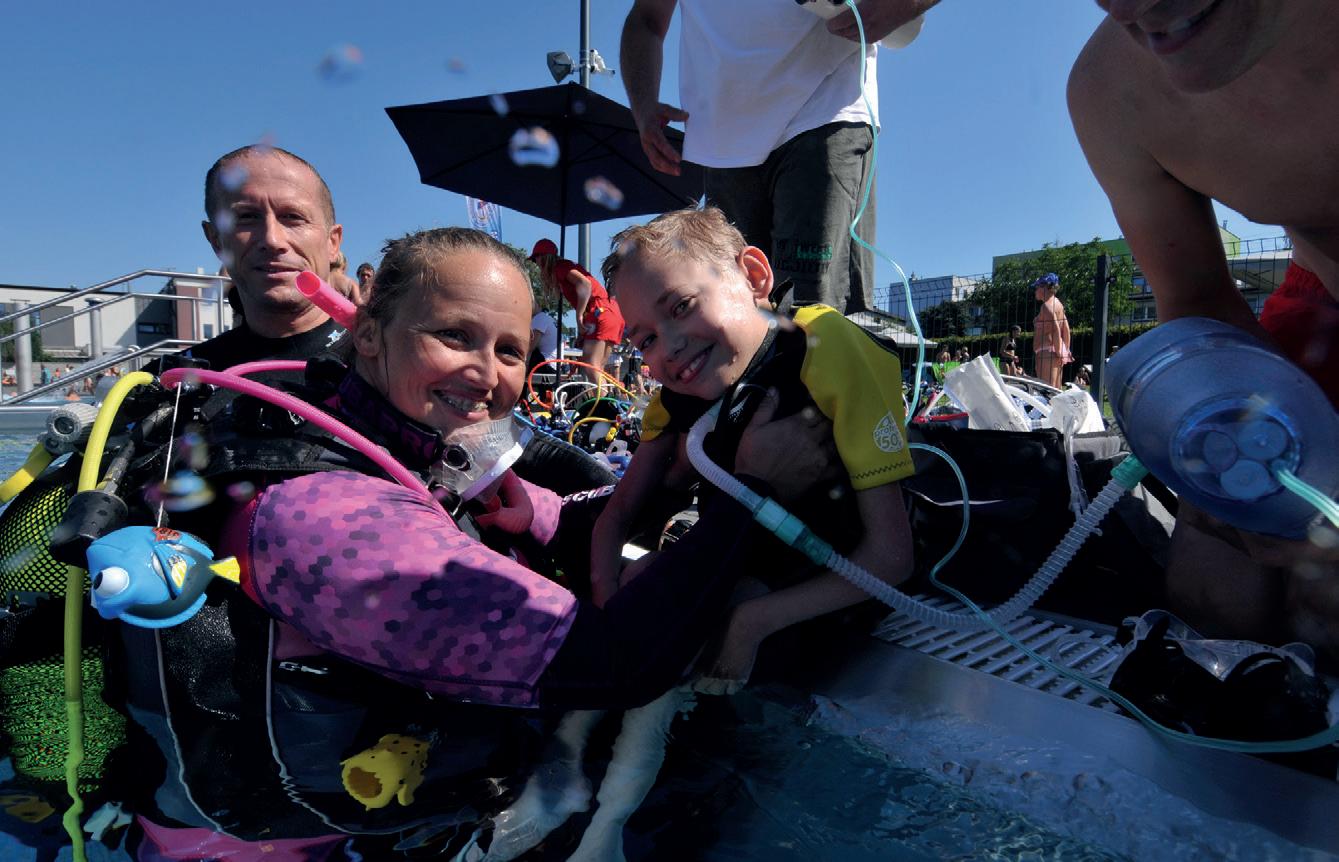
hope in his voice; he seemed to be trying to gently convince us to entertain the idea. He was utterly shocked when he heard me say, “Sure, let’s give it a try!”
Of course, not everything can be done, but if we don’t try, we’ll never know where the limits are. Dreams need to be dreamed, fulfilled, and then repeated in a loop. With Franek, it wasn’t as simple as “suit up and into the water.” During our first meeting, our initial ideas burst like a soap bubble. Naturally, right after the conversation with Franek’s doctor, we discussed the possibilities for individuals who cannot walk, sharing experiences and brainstorming solutions. We initially considered using small three-liter tanks and adapting a mask with an MTV valve from a DAN kit. What’s that? To simplify: it’s a manual ventilation system, comparable to the bypass button on the second stage of a regulator.
Our brainstorming sessions were intense. Writing this now, I smile at how quickly our bubble burst. The tank and BCD were immediately ruled out. Franek’s range of motion is limited to his hands – he controls his wheelchair joystick and can lift light objects by clasping his hands together. Unused muscles atrophy, so heavy equipment was out of the question.
It was essential to get Franek into a wetsuit, though every time I noticed he was getting cold, he never wanted to leave the water and always stretched his time in it as much as possible. A mask was necessary to improve visibility and prevent water from getting inside.
The most challenging part, of course, was breathing. Franek uses a tracheostomy tube and a ventilator daily. So, what do you take underwater? Franek’s safety was paramount at every stage, and everything was meticulously consulted with a doctor. In fact,
Franek’s first dive took place with his doctor, who is also a diver.
This wasn’t something we figured out and executed in one meeting. There were fittings, modifications, and adjustments. But we made it work – not just once but several times, and I had the pleasure of diving with Franek on those occasions. Was it worth the time and energy? A thousand times YES!
Franek fulfilled his dream, but his achievement also inspired many other people with disabilities to venture out of their comfort zones. After all, if Franek can dive with his condition, why shouldn’t others give it a try? Ania, Franek’s mom, runs social media and a blog, @MójSynFranek, and after sharing Franek’s diving story, many people reached out, initially believing they could never dive. But they tried – and loved it.
Diving is a recreational sport. We’re not all highly trained commandos – fit, healthy, and young – and thank goodness for that! Diving is for (almost, editor’s note) everyone. Ultimately, a doctor makes the final call. Because none of us are perfect, equipment manufacturers have developed various solutions to accommodate different needs. For example, prescription lenses for masks are now so common that people no longer worry about what to do with their glasses; they just choose a mask that fits prescription lenses or opt for contact lenses.
Divers with mobility challenges now have a range of ultra-light fins to choose from – or they can skip fins altogether and use an underwater scooter instead. Most solutions already exist; the key is identifying the problem and solving it.
Unfortunately, in Poland, only a few places have water lifts or specialized entrances for people who cannot walk. While such features are standard in new facilities, older swimming pools

often lack not only convenient water access but also wheelchair accessibility due to numerous stairs. And open water? Haha, only a handful of Polish dive bases have created safe and comfortable water entry and exit points – even for fully mobile divers.
But we don’t dive solo. Diving is a highly social sport, and someone is always there to help carry equipment into the water, so you can suit up once you’re in and remove it the same way.
Personally, I’m thrilled that we’re recognizing the needs of others – not pointing fingers but striving to make life easier for everyone.
For young people 15 and older, there are now specializations available that teach how to be a partner to a diver with special needs. PADI offers the Adaptive Support Diver course, which, simply put, trains divers to assist in adaptation. The course emphasizes empathy and addressing individual physical and psychological needs. Disabilities aren’t always visible; PTSD, cancer, or diabetes are just a few examples.
During training, participants simulate visual and mobility impairments, try to grab something from a high shelf while seated in a wheelchair, or attempt to navigate narrow doors. Unfortunately, the list of obstacles is long. If someone wants just a taste of this knowledge, it can be one of the five sessions in the Advanced Open Water Diver course.
In previous articles, I wrote about essential specializations for recreational divers exploring the underwater world (like deep diver, nitrox, and wreck). However, I can’t imagine a Divemaster without the Adaptive Support Diver course.
From the start, my series of articles has aimed to show how to turn a passion into a career – a year-round or seasonal way of life. The next article will be all about stories, tips, and possibilities.
When planning this article, I knew that besides Franek, I had to include my beloved Daga. This is a story about an amazing woman I met while living in Egypt. I was a Divemaster, and Dagmara was just starting her diving journey as a newly minted “OWD” (Open Water Diver). Fast forward many years, and today Dagmara lives in Poland. Her daily job involves office work, but on weekends, she works with a diving association for people with disabilities. Dagmara and her partner, Adaś, both dive – but this story is about her. Adaś will be in the background; I send him my regards – he’ll be happy with that.
Tourism isn’t the easiest path, but the travel and adventure it brings make up for it. You constantly meet amazing people. They come for a week, you form a great connection, and after boat trips, you arrange to go out together or have dinners in town. Sometimes, you meet people you invite home to cook shrimp and calamari together. It’s fantastic. The vacation ends, and the new friends return to their routines and responsibilities. You might stay in touch via SMS for a while, but time often fades those connections – though sometimes only until the next diving trip. Rarely, the contact becomes almost daily and lasting.
I stayed in Egypt for almost two years without any breaks, which is a long time – anyone who has spent two weeks there can confirm that! Visits from friends were always like a breath of fresh air. They made me feel at home and empathized with my frustrations about local absurdities – it was like Christmas in August. Dagmara and Adaś visited for diving, of course. They dove a lot, trained consistently, and we explored dive sites reserved for experienced divers. These included deep dives, wreck dives, and those with strong currents. Fortunately, they were always up for more, so it was easy to convince them to dive again – sometimes even at night from the shore. (Sadly, night diving from the shore has been prohibited in Egypt for the past three years, and night dives from boats now require special permits.)
In Hurghada, near the Sunrise Holidays Hotel, there’s a small pier about 8 meters long. Despite its size, it was teeming with life. The key to a good night dive is waiting an hour after dark before heading underwater. With little light from the hotel reaching the water, only our flashlights revealed what lurked in the darkness. The thrill was real – I even jumped once when a moray eel darted between my legs to attack a fish I had illuminated.
After such eventful days, we’d head to Pub Joly, which inspired Dagmara to name her dog after it. It was there that the decision to welcome a new family member was made. We have countless stories and lots of time has passed, but even without regular contact, it’s easy to pick up a conversation as if it ended just yesterday. Diving can forge lifelong bonds.
Now, Dagmara is actively involved with the Silesian Association of Disabled Divers, promoting the idea of “Diving for Everyone.” They leave disabilities at the shore and “heal” through the water – all driven by love for people and the ocean.
I asked Dagmara to share a few words about her work: “I started diving because I didn’t want to be the one left on the pier guarding the shoes when the crew went diving. Any reason is a good one! The day after getting my first OWD certification and logbook, we went on a two-week trip to Egypt. We immediately booked a twoweek diving package, and that’s when I truly fell in love – with the silence, freedom, and colors. I heard my own breathing and knew this couldn’t just end there. In Egypt, I met Dobroć, Kasia, Adi, and many other divers who welcomed us into their diving family, making us feel at home – thanks to that crew.
After a few trips where I kept training (regularly bringing Polish delicacies like sourdough starter for żurek, much to the customs officers’ surprise), I read a notice back in Poland: ‘Volunteers needed to swim and dive with people with disabilities.’ The next day, I attended my first session.
Diving with people with disabilities deeply changed my perspective and priorities in life. I learned to appreciate the little things, think more broadly, and come up with solutions that might seem unusual but work perfectly in this context. People with disabilities face far more challenges to dive than most, yet they never complain or grumble. In the water, they are equal partners and amazing teachers of patience, perseverance, and determination. After every dive, their smiles mirror my own.
Water is an incredible environment for rehabilitation – it lifts and soothes, reduces spasticity, alleviates pain, and, most importantly, fills them with positive energy and self-confidence. Thanks to diving, they can leave home, meet like-minded people, and leave their disabilities at the shore.”
As you can see, diving truly is for everyone. Let’s all take care of our waters.



Text and photos ALDONA DREGER

DIVING, ALTHOUGH FASCINATING AND FULL OF EXCITEMENT, IS A SPORT THAT REQUIRES FULL PHYSICAL AND MENTAL READINESS FROM THE BODY. EVERY DIVER, REGARDLESS OF THEIR LEVEL OF ADVANCEMENT, KNOWS HOW IMPORTANT IS PROPER EQUIPMENT PREPARATION, DIVE PLANNING AND TAKING CARE OF YOUR FITNESS. BUT THERE IS ANOTHER, OFTEN OVERLOOKED ASPECT THAT CAN HAVE A HUGE IMPACT ON THE COURSE AND SAFETY OF DIVING – PROPER DIET AND HYDRATION.
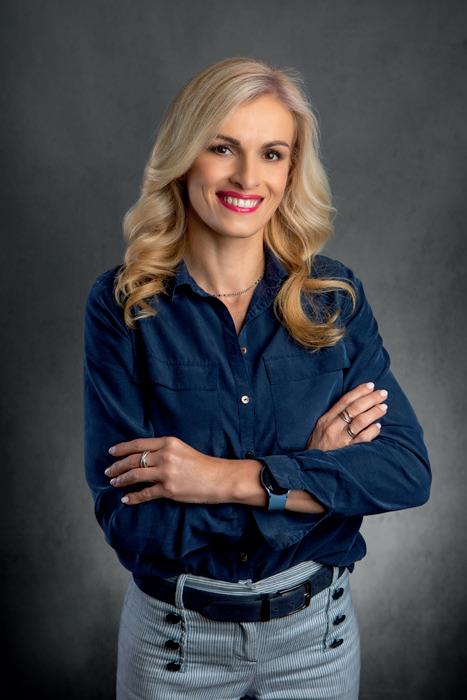
In this article, we'll look at how proper nutrition can improve our comfort underwater and prevent the potential dangers of decompression sickness (DCS) and other health risks.
In the article, I asked for cooperation an exceptional specialist – a sports dietitian, university lecturer and dietitian of the national wrestling team – Justyna Mizera Our guest is also the author of several respected publications, such as Sports Dietetics and Nutrition of a Young Athlete. Privately, apart from his professional activity, she is passionate about long-distance running
Underwater, our body is in unique conditions – the pressure increases, the body's gas balance changes, and maintaining body temperature requires additional energy. Therefore, what we eat before diving can significantly affect our performance and well-being.
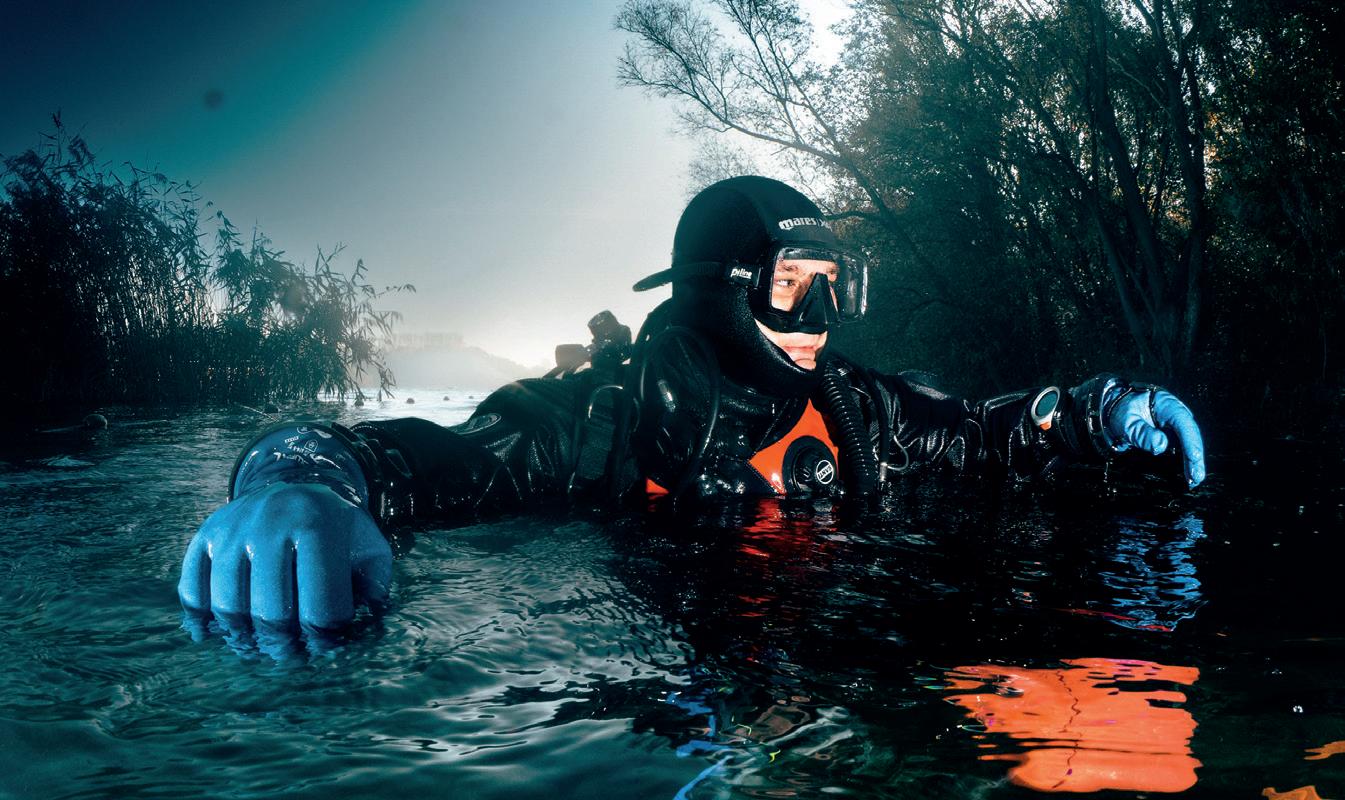
Good nutrition before diving provides us with a constant supply of energy, which is necessary to maintain proper concentration and strength. Adequate blood sugar levels prevent weakness and fatigue, which can lead to distraction and an increased risk of making mistakes. It is worth reaching for complex carbohydrates (wholemeal bread, porridge) and healthy fats (nuts, avocados), which will gradually provide energy over a longer period of time.
A drop in blood sugar during diving can manifest itself in a feeling of weakness, dizziness, and in extreme cases even loss of consciousness. Therefore, it is recommended to eat a light meal with a low glycaemic index before diving. Let's avoid simple sugars (sweets, carbonated drinks), which quickly raise glucose levels, but also quickly lead to a sharp drop.
Underwater, contrary to appearances, is very easy to get dehydrated. Equipment, cold water and even increased urine secretion as a result of pressure on the kidneys under pressure (so-called diving diuresis) – all this makes hydration crucial. You should make sure to drink water regularly before diving and avoid alcohol or diuretic beverages such as coffee. Dehydration can lead to muscle cramps, headaches, and even decompression problems.
In addition, dry and cold air in the tank, along with the fact that divers breathe through their mouths, can definitely increase the risk of dehydration. Let's take a look at how these factors affect the diver's body.
The air in the scuba cylinder is highly dehumidified during compression, which means that it does not contain moisture. When a diver breathes such air, the body needs additional water reserves to hydrate the respiratory track. The humidity of the inhaled air is high under normal conditions, and the water from the environment supports this process, but underwater, all this effort "falls" on the diver's body, which increases water loss.
When the diver is at greater depths, the temperature of the water and air in the cylinder may be lower, and the cold air additionally dries out the mucous membranes. In a cold environment, the body works harder to maintain an optimal temperature, which often leads to faster fluid loss, even if it is not immediately felt.
Breathing through the mouth (rather than through the nose) can also increase the risk of dehydration. Inhaling air through the nose allows the inhaled air to be humidified and partially heated before it enters the lungs, which reduces moisture loss. However, when we breathe through the mouth, especially in diving conditions, this mechanism does not work and the mucous membranes dry out faster, which leads to additional water loss.
Underwater, especially with more physical exertion or in cold water, divers breathe faster. This causes the body to lose water even faster – more breaths mean more dry and cold breaths, which dehydrate the respiratory tract.
Dehydration is a condition in which the body loses more water than it can take in. It is a dangerous condition for everyone, but in the case of divers it has additional, serious consequences. Lack of proper hydration can lead to headaches, fatigue, reduced physical performance, disorientation, and even disorders of body temperature regulation and muscle cramps. More importantly, dehydration increases the risk of decompression sickness.
During diving, and especially during ascents, nitrogen dissolved in the body tissues must be excreted in a controlled manner. Dehydration affects blood concentration and reduces its volume, which hinders the process of gas exchange in the body. This, in turn, means that the body is slower to get rid of excess nitrogen, which can lead to the formation of dangerous gas bubbles and increase the risk of DCS.
Research conducted by DAN (Diving Safety Laboratory) shows that many divers are not properly hydrated both before and after diving. This problem becomes even more evident during diving holidays when there is intense activity and the impact of high temperatures. It is therefore worth emphasising that proper hydration is essential not only for comfort, but above all for safety underwater.
All of these factors add up, increasing the risk of dehydration during a dive. That's why proper hydration before, between and after diving is so important. Thoughtful hydration, especially during intense diving days or at great depths, can help minimise these effects and improve diving safety and comfort.
Hydration requires the right approach
Improper water absorption
Drinking a lot of water rapidly causes some of the fluids to be quickly excreted from the body. This means that the body will not have time to effectively use water to hydrate tissues. As a result, you can feel thirsty even after drinking a lot of water, because the body is not effectively hydrated.
Drinking large amounts of water in a short period of time can also lead to dilution of electrolytes in the body, which can be especially dangerous during increased physical exertion. Electrolytes are crucial for muscle and nerve function, so a lack of them can lead to weakness, cramps, and even more serious disorders.
According to sports nutritionist – Justyna Mizera, the type of fluids consumed, including water and the minerals it contains, is important. It is worth reaching for moderately mineralised, and sometimes even highly mineralised, because it is the presence of electrolytes, especially sodium, that helps to retain water at the level of inter-cellular spaces. At low sodium levels in the body, water is excreted faster through the kidneys, which can promote dehydration.
between dives
Divers often make the mistake of trying to quickly replenish
fluids just before diving. However, the body needs time to hydrate properly, so the optimal approach is to regularly sip small amounts of water throughout the day, both before and after diving.
How to hydrate properly?
For divers (and not only), the best method is to regularly drink small amounts of water during the day. Some key tips:
Pre-dive
Start drinking water a few hours before the planned dive, drinking small amounts every few minutes. This allows the body to absorb fluids well and evenly hydrate the tissues. Choose medium or high mineralised water, but not sparkling water. Pay attention for the content of electrolytes and bicarbonates, which act as a buffer – says our expert.
Hydration after diving is equally important, as your body may still be in a state of slight dehydration after getting out of the water. It is worth continuing drinking small portions of water to compensate for any losses.
Drinking water with added electrolytes can be beneficial, especially for long or intense dives. This makes it easier to replenish minerals lost through sweat and improves the absorption of fluids.
With these habits, the diver increases their safety and comfort, as well as reduces the risk of dehydration, which, as we mentioned earlier, can increase the risk of decompression sickness and other health problems.
Proper hydration begins long before entering the water. Here are some rules to keep in mind to avoid dehydration and minimise the risk of DCS:
1. Drink water regularly throughout the day – Drink water in small sips between meals, avoid consuming large amounts of fluids at once.
2. Avoid dehydrating drinks – soffee, tea, and alcohol have a diuretic effect, which contributes to faster fluid loss. Before and after diving, it is worth limiting their consumption and drinking more water or herbal infusions instead.
3. Pay attention to the climate – In hot, tropical climates, where diving often involves intense sun exposure, the body loses more fluid through sweating. In these conditions, it is necessary to drink more water to avoid dehydration.
4. Hydration after diving – Divers often forget that the body also needs adequate hydration after diving. The body's recovery process continues long after you get out of the water, so drinking water after a dive is just as important as it was before. According to a sports nutritionist – Drinks with added glucose can also be used here. It can be a natural product, such

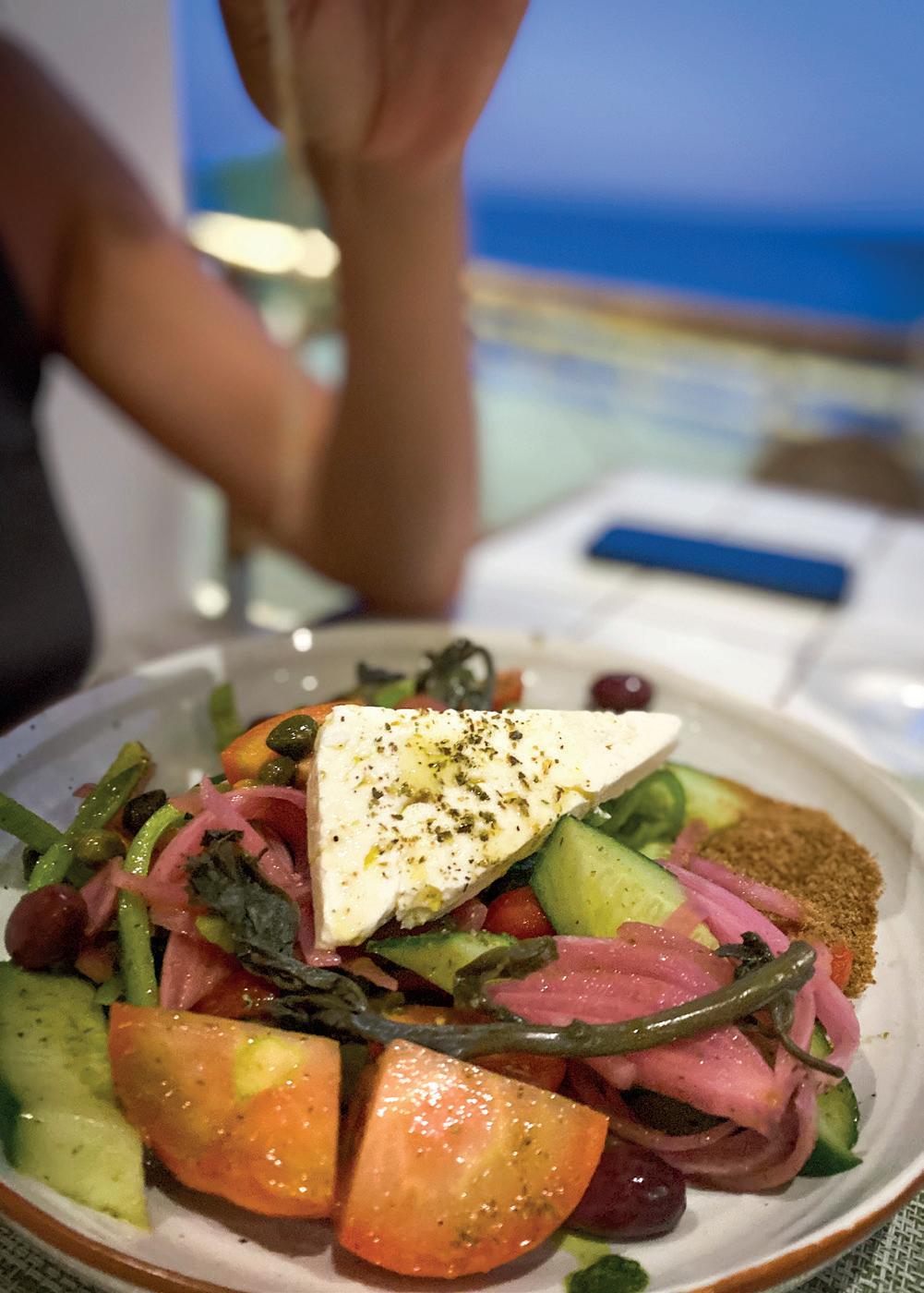
as coconut water, or an isotonic drink, or in its simplest form, water with salt and honey.
Sample diet of a diver before, between and after diving
Pre-dive
Breakfast or a light meal a few hours before going underwater is essential. It can be, for example, porridge with nuts and fruit or wholemeal bread with low-fat cottage cheese and vegetables. It is important that the meal is easy to digest, but at the same time provides the necessary nutrients.
Protein-carbohydrate shakes, e.g. based on plant milk, bananas, spinach and chia seeds, also work well. They are light, but they give a sense of satiety and provide valuable ingredients such as protein and minerals.
Justyna Mizera – It should be borne in mind that liquid or semi-liquid meals move faster through the digestive tract, and thus release energy faster, so it is necessary to adjust the form of the meal to the time between its consumption and entering the water. In addition, fat is an important addition to the cocktail, because thanks to its content, there is no sudden increase in blood glucose levels after eating blended fruit or cereals. The addition of chia seeds, peanut butter or avocado will be a good solution.
Between dives
Bananas are a great source of electrolytes, in particular potas-
sium, which is essential for the proper functioning of muscles, blood pressure regulation and the body's water-electrolyte balance. Including them in a diver's diet is a good idea, especially as a snack before or after a dive. The potassium they contain can help prevent muscle cramps, which is especially useful during physical exertion, including underwater.
Here's why bananas can be a valuable addition to a diver's diet: bananas contain natural sugars that provide energy quickly, which can be useful before diving.
Justyna Mizera – Depending on the time of consumption, we have a choice of unripe bananas, green and hard and such can be eaten even 45 minutes before exercise, while bananas highly ripe, and thus also with a higher proportion of simple sugars, is a good solution for a quick energy shot, even 10-15 minutes before activity.
The potassium in bananas supports electrolyte balance and can be helpful in recovery after diving, especially in warmer climates where the body loses more electrolytes.
Bananas are convenient to take with you and can be eaten quickly between dives, without the need for additional preparation.
Potassium from bananas helps the body retain water better, which supports overall hydration.
Of course, bananas can be one of the elements of a balanced diet, but they are not enough on their own to fully hydrate and replenish all electrolytes. Therefore, it is best to combine them with water and other sources of minerals to ensure optimal condition of the body before and after diving.
Sports nutritionist Justyna Mizera – After the dive, it is worth eating a regenerative meal, it should quickly provide a portion of protein and simple carbohydrates in the amount of about 1g/kg of body mass because after exercise the body uses them to resynthesize muscle glycogen faster. It is also worth ensuring that protein is quickly delivered to the muscles in order to repair micro-injuries, hence a good solution is high-protein yogurt or a protein bar. The next meal is again a portion of protein, e.g. from fish or poultry with the addition of complex carbohydrates, such as quinoa or wild rice.
Some studies suggest that a proper diet can also affect the decompression process. Eating large amounts of fats can increase the risk of microbubbles of nitrogen in tissues, which in turn can lead to decompression sickness. On the other hand, a diet rich in antioxidants (vegetables, fruits, nuts) can support the body in the fight against free radicals and reduce the risk of complications.
Decompression sickness (DCS) is a serious medical problem that can occur as a result of too quick surfacing or failure to make decompression stops. Symptoms occur when excess inert gas, dissolved in the tissues of the body, creates gas bubbles that interact with the surrounding tissues and circulatory system. Although the principles of safe diving are widely known and applied, practice shows that the risk of DCS is influenced by many additional factors, such as dehydration, fatigue, cold and stress.
Dehydration is one of the main risk factors for DCS because it reduces the volume of the blood, which can lead to faster gas bubbles. Similarly, oxidative stress, i.e. an imbalance between free radicals and antioxidants in the body, can increase susceptibility to cell damage underwater. Free radicals that are formed, among other things,during metabolic processes, can damage cells and tissues, which increases the risk of medical complications during diving.
That is why it is so important that the diver's diet includes adequate amounts of antioxidants that neutralise free radicals. These substances can be found in many foods, especially fruits, vegetables and nuts, which should be the basis of every diver's diet.
A proper diet affects the diver's health not only on the surface, but also underwater. One of the key problems faced by divers is oxidative stress, which is an imbalance between the production of free radicals and the body's ability to neutralise them. Free radicals, formed alsoduring metabolic changes and respiratory processes, they can damage cells and tissues, which leads to fatigue, reduced efficiency and an increased risk of DCS.
Antioxidants, which neutralise free radicals, can be found in many foods, such as fruits, vegetables, nuts, and seeds. A healthy, antioxidant-rich diet helps the body cope with this problem. Here are some rules to introduce into your diet:
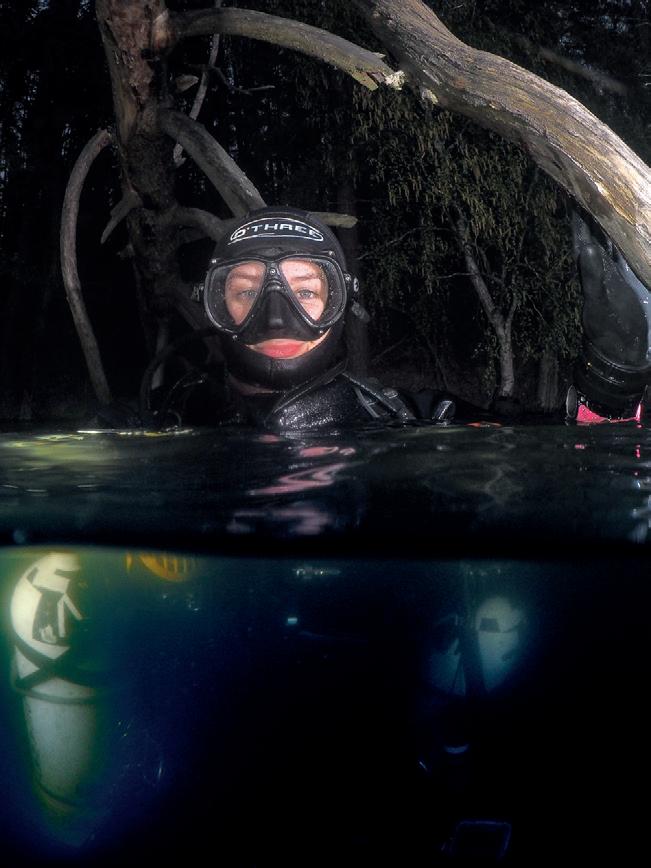
1. Eat more fruit and vegetables – products such as berries, spinach, broccoli and tomatoes are rich in vitamins C, E and carotenoids, which act as powerful antioxidants. Include them in your daily menu to support the body in the fight against oxidative stress. Justyna Mizera – In the off-season, reach for frozen berries, such as raspberries, blueberries, currants, because they are still an excellent source of antioxidants.
2. Avoid processed foods – highly processed foods, high in trans fats and simple sugars, can increase the production of free radicals. Choose natural, unprocessed products to support metabolic health.
3. Pay attention to fat sources – Omega-3 fatty acids, which are found in fish, flaxseeds, and walnuts, have anti-inflammatory properties and help reduce oxidative stress. Include them in your diet to support your body's recovery after diving.
Proper hydration is a key element affecting the comfort and safety of diving. Water plays an important role in metabolic processes, facilitates the elimination of toxins from the body and supports the proper functioning of the circulatory system.
A diver who does not take care to drink water regularly before diving is more likely to become dehydrated, which can lead to an increased risk of DCS.
The ideal practice is to sip small amounts of water throughout the day, rather than consuming large amounts of fluids at once. It is worth avoiding highly mineralised water and drinks containing caffeine and alcohol, which have a diuretic effect and can lead to dehydration.

The role of intestines function and detoxification
A well-functioning intestines is the key to health. The intestines are responsible for the absorption of nutrients and also constitute an immune barrier. A healthy diet, rich in fibre, helps maintain proper bowel function, which has a direct impact on overall well-being, including the body's ability to cope with stress and recovery from physical exertion such as diving.
Summary
Good nutrition is the key to safe and comfortable diving. A proper diet not only provides energy, but also helps to maintain concentration, prevents dehydration and supports the body's recovery after diving. Remember that what we eat on the surface has a direct impact on our safety underwater.
Remember that diving is not only about equipment and technique, but also about preparing the body to face the extreme conditions in which it is underwater. Take care of yourself every day, and every dive will be not only safe, but also enjoyable.



DIVING GLOVES PLAY A CRUCIAL ROLE IN PROTECTING A DIVER'S HANDS FROM COLD, ABRASIONS, PUNCTURES, AND CONTACT WITH HAZARDOUS ORGANISMS. RECENTLY, IT BECAME EVIDENT THAT THEY OFFER YET ANOTHER NOTABLE BENEFIT – BUT MORE ON THAT LATER.
In diving, there are two main types of gloves: wet and dry. Each type has its advantages and disadvantages, which should be considered based on diving conditions and what kind of glove power you’re looking for.
Wet Gloves – made of neoprene, sometimes combined with materials like leather, Kevlar, or others. Wet gloves can be worn without additional fastenings (although an improper fit might cause them to slip off when water gets inside). They may feature
zippers for a tighter fit around the wrist or Velcro straps to adjust to wrist thickness.
ADVANTAGES:
1. Cold Protection – Neoprene gloves provide excellent thermal insulation. When water enters the gloves and warms up from body heat, it creates an insulating layer against colder surroundings.
2. Flexibility – Wet gloves are flexible, giving divers greater dexterity and better tactile sensitivity underwater.
3. Ease of Use – They are easy to put on and take off, requiring no complex sealing systems.
4. Affordability – Generally, wet gloves are more budget-friendly than dry gloves.
DISADVANTAGES:
1. Limited Thermal Protection – In very cold waters, wet gloves might not suffice, as the water layer inside can cool down, leading to heat loss.
2. Susceptibility to Damage – Neoprene is prone to wear and may not provide adequate protection against sharp objects or coral.

Dry Gloves – attach via a ring system that connects to a dry suit, often worn over thin wool or cotton gloves for added warmth.
ADVANTAGES:
1. Complete Thermal Protection – Like a dry suit, they prevent water from entering. Additional liners can be used for extended dives in cold water.
2. Protection from Mechanical Damage – Made from durable materials, dry gloves are more resistant to abrasions, punctures, and contact with sharp objects.
3. Versatility – They perform well in extreme conditions, such as ice diving or deep technical dives.
DISADVANTAGES:
1. Reduced Dexterity – Dry gloves, especially when combined with warmers, can restrict finger movement and make precise underwater tasks more challenging.
2. Seal Requirements – They need to be properly fitted to the dry suit, which can be time-consuming and inconvenient, especially in the field.
3. Higher Cost – Dry gloves are typically more expensive than wet gloves and require additional maintenance.
In technical diving, where water temperatures range between 3–7°C (37–45°F), dry gloves are almost universally used. In recreational diving, wet gloves are more common, with neoprene thicknesses ranging from 2 to 5 mm.
From the perspective of diving ethics, touching animals underwater is not recommended. This can lead to several negative consequences:



1. Stress for animals – Even gentle contact can cause stress for marine organisms, especially species unaccustomed to human interaction. We shouldn’t grab octopuses or play with them—this causes immense stress for them.
2. Damage to organisms – Many animals have delicate skin, corals are sensitive to touch, and contact with hands can result in micro-damage or infections.
3. Disease transmission – Pathogens can unknowingly be transferred from one organism to another.
4. Danger to the diver – Some organisms may be venomous or toxic. Touching sea urchins, jellyfish, or certain types of fish can lead to painful injuries.
Instead of touching animals, it’s better to observe them from an appropriate distance to avoid disturbing their natural behavior and ecosystem.
Actually, there’s something we must touch—trash that someone else, whether a friend or a stranger, has thrown into the water. Such waste needs to be carefully picked up and placed into a bag so it can later be disposed of properly.

In many cases, accidental contact occurs, for instance, with a piece of reef, which can often be dangerous for the diver. It can cause cuts, sometimes quite deep. Interaction with marine creatures is also possible. Curious seals might brush against a diver, gently grab their fins or hand. Some fish may attack divers who pass too close, giving them a "peck" on the hand—for example, clownfish or small groupers.
In my opinion, it’s worth having gloves for your own protection. But never to intentionally touch animals. So, may the power of gloves be with you. Choose the right size and enjoy your underwater encounters and exploration.
What did I discover quite recently? Gloves have some kind of mysterious power. It turns out they can counteract the irrational fear of being surrounded by schools of fish. Occasionally, OWD students, when immersing their heads into a clear ocean for the first time, may be afraid of fish. It doesn’t matter that they don’t bite or aren’t venomous—the issue is that “they’re close, all around, and moving fast...” Amazingly, wearing gloves can alleviate this fear :)





